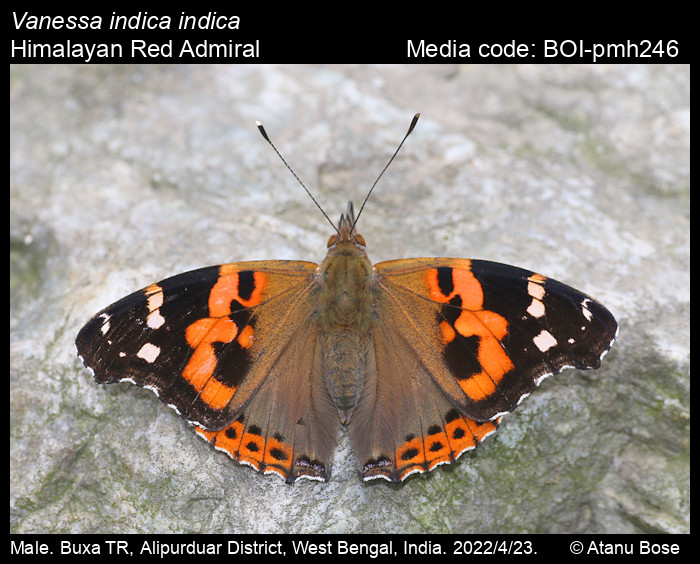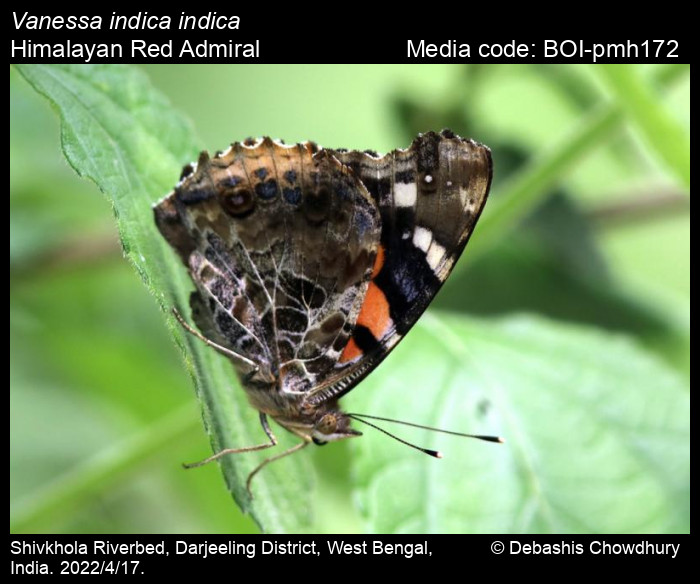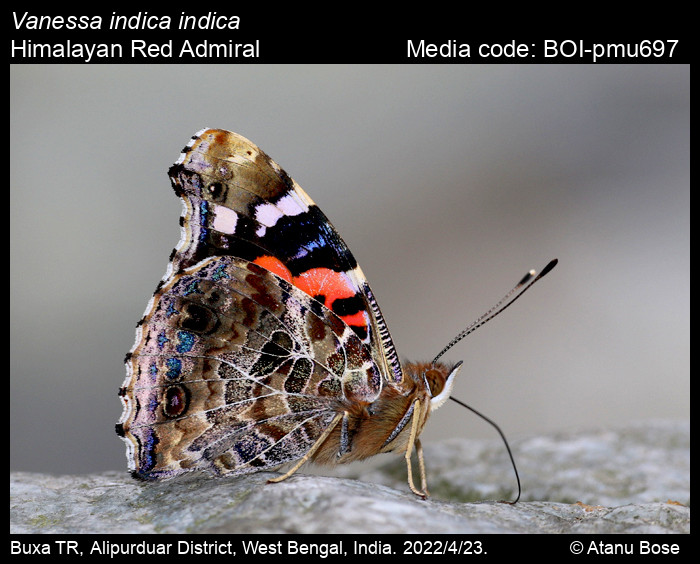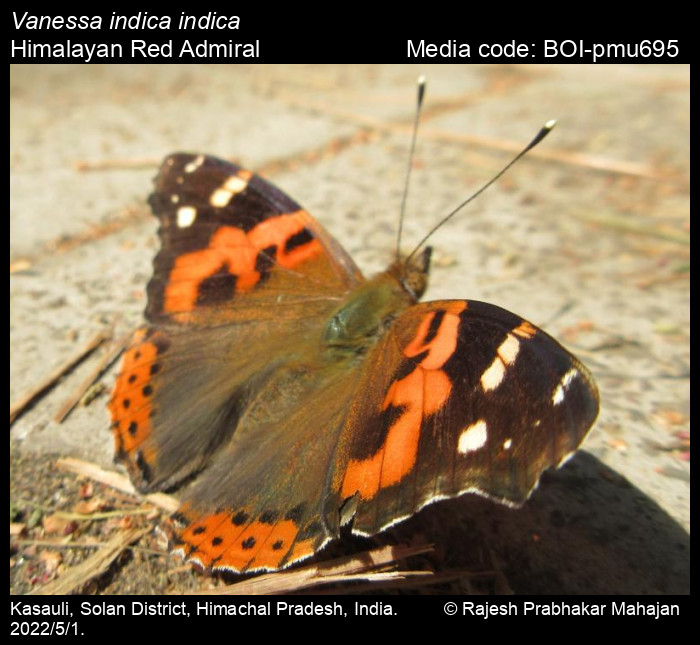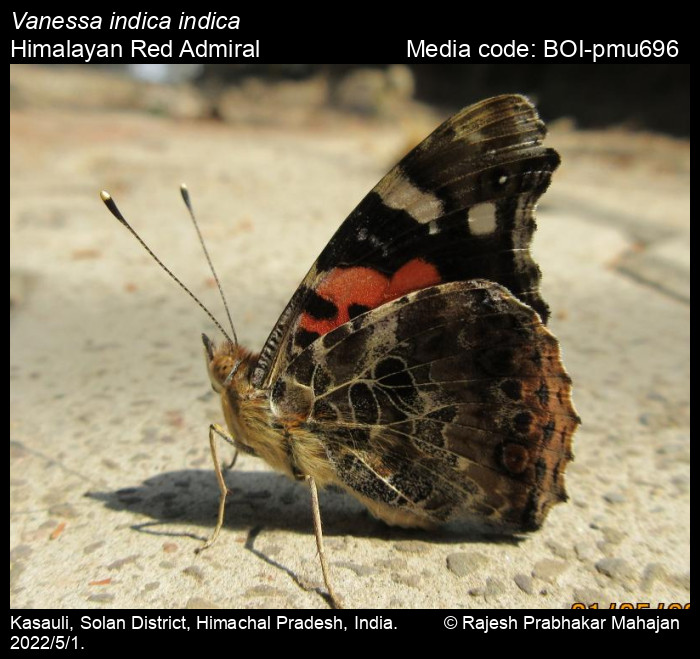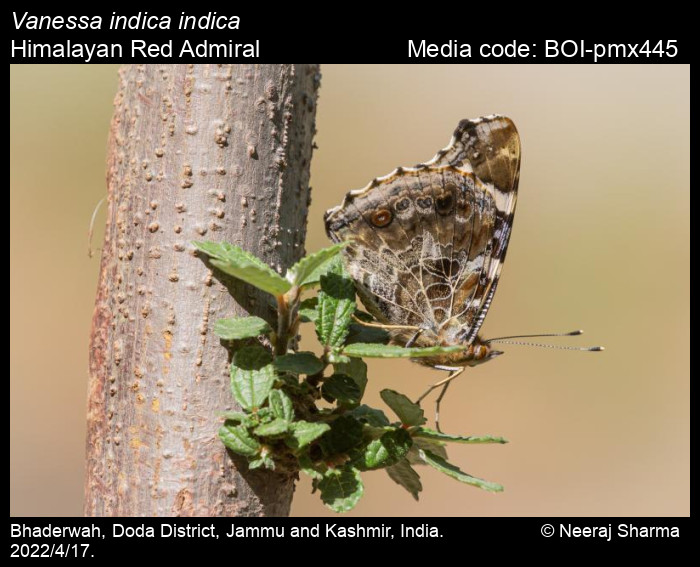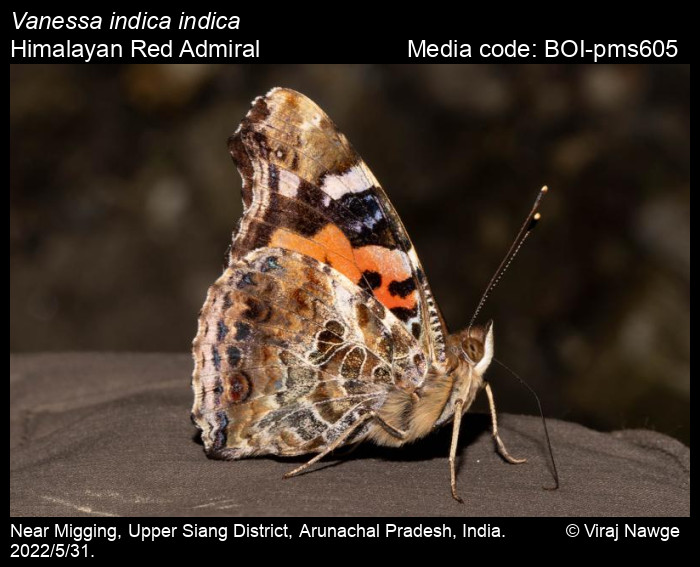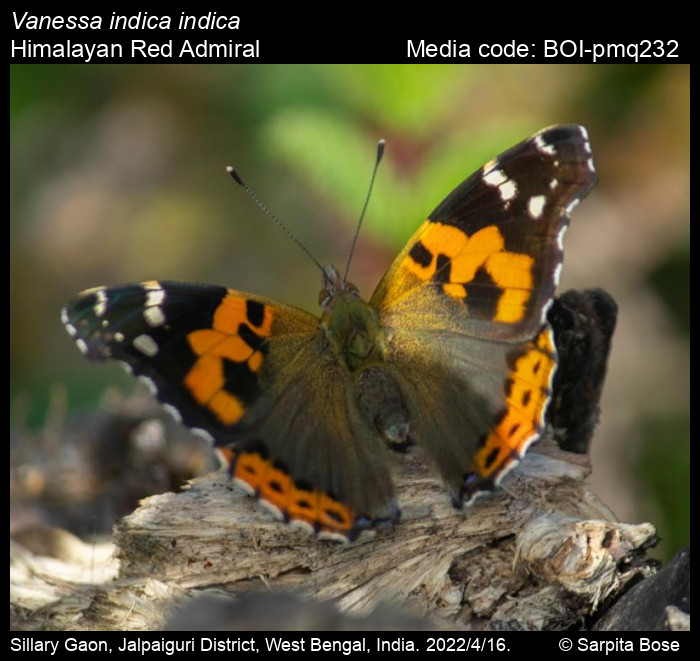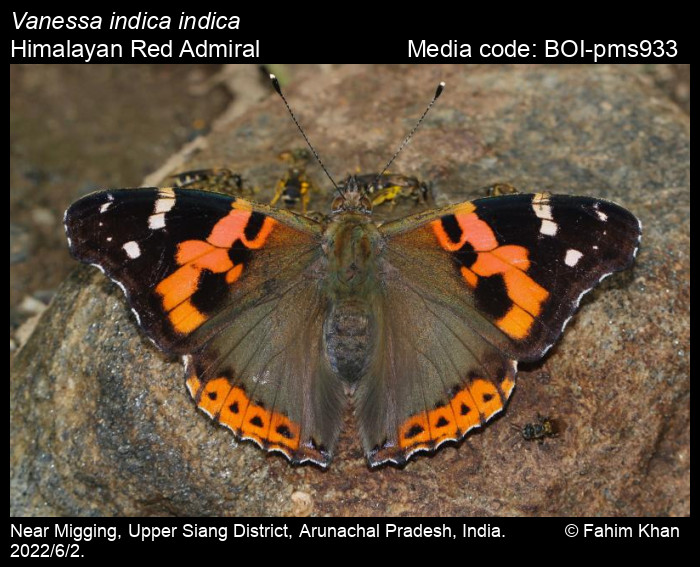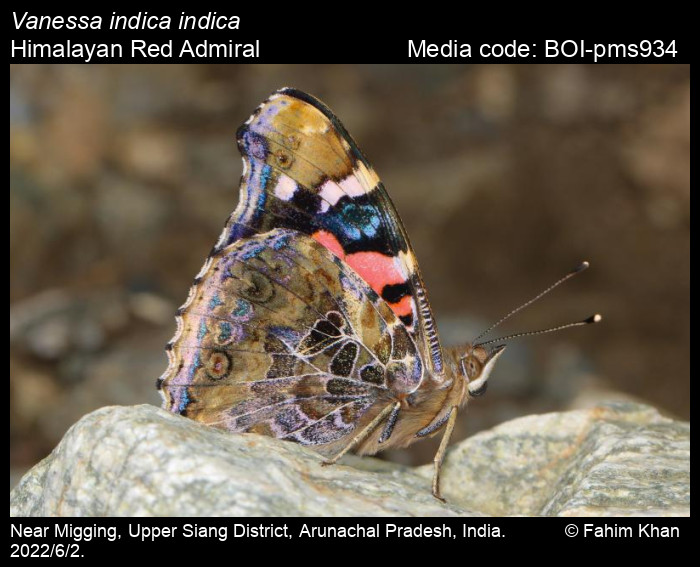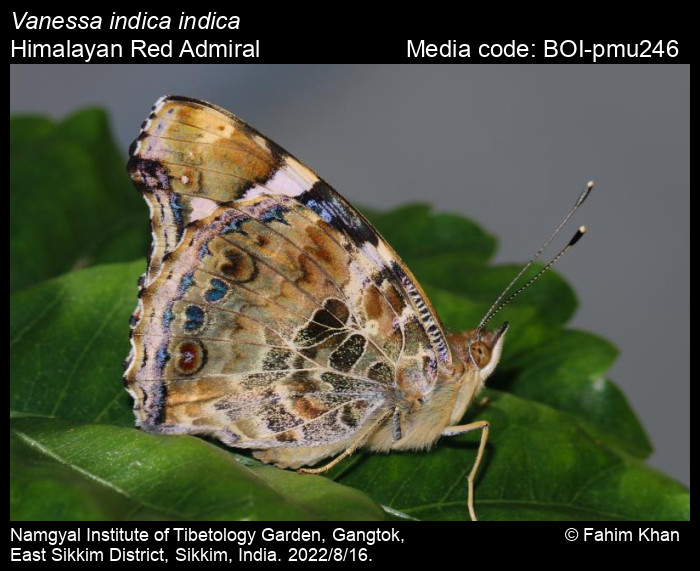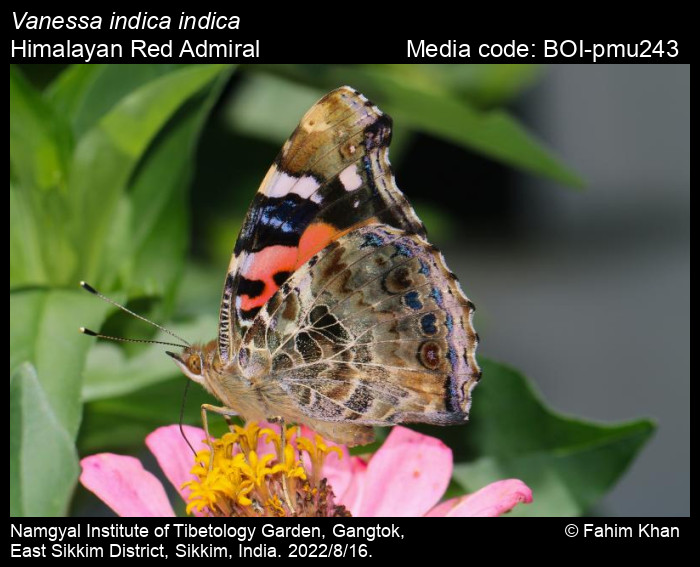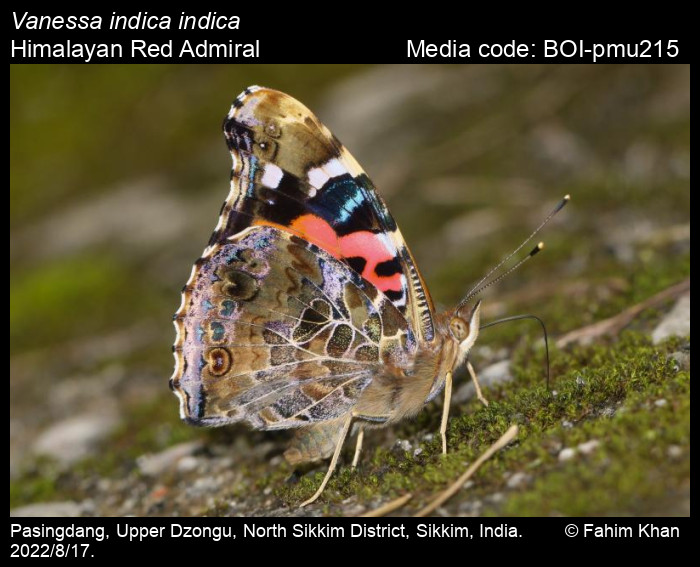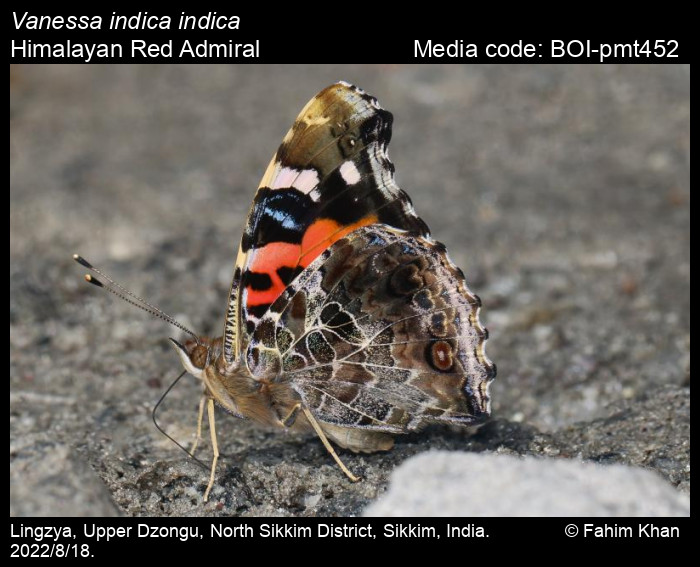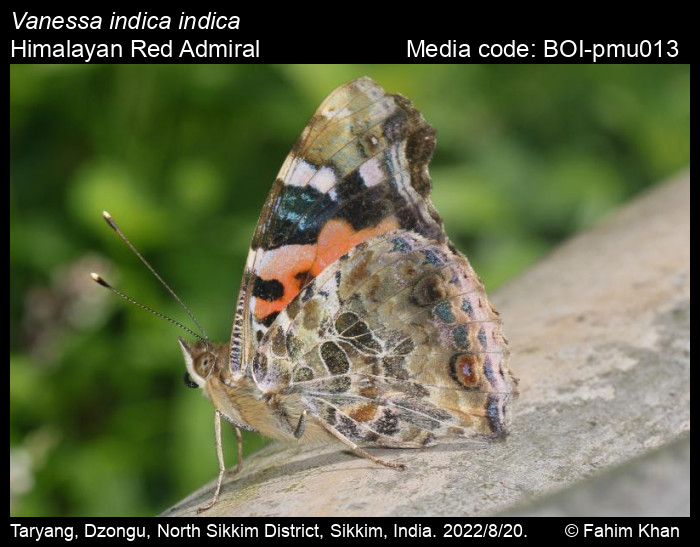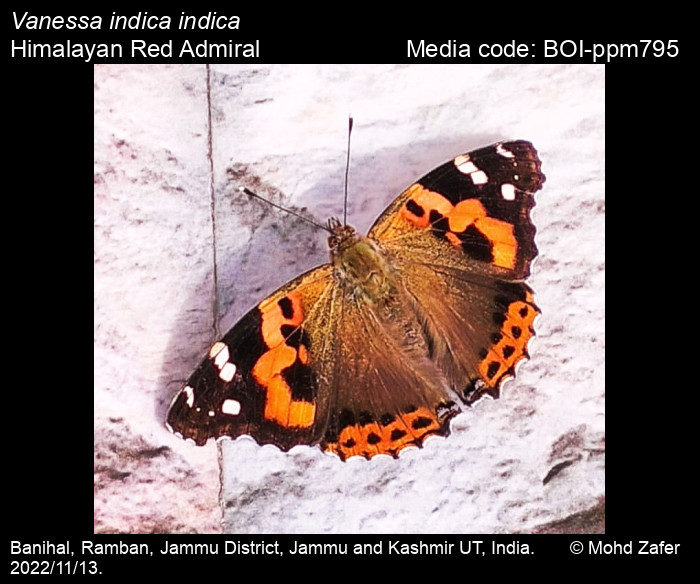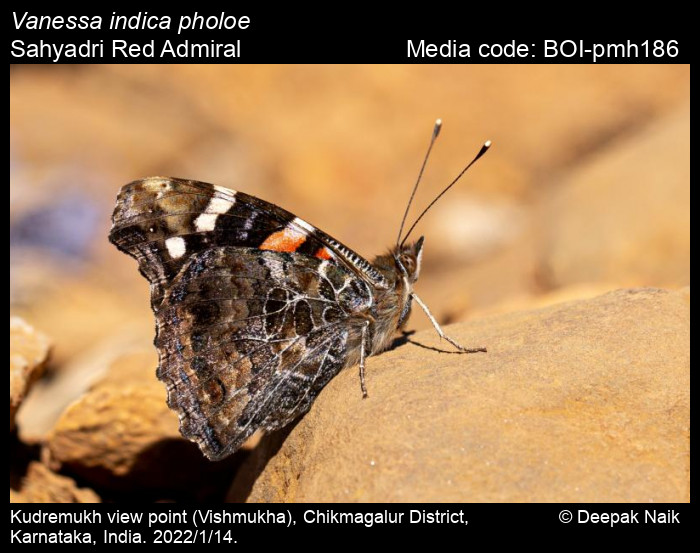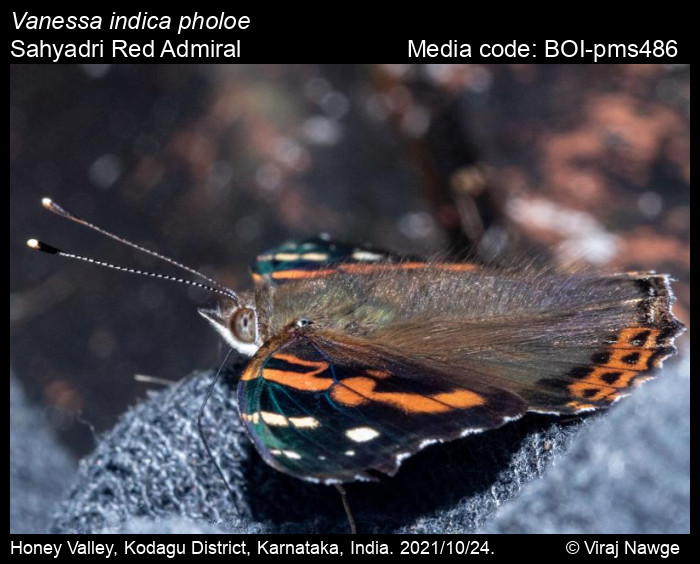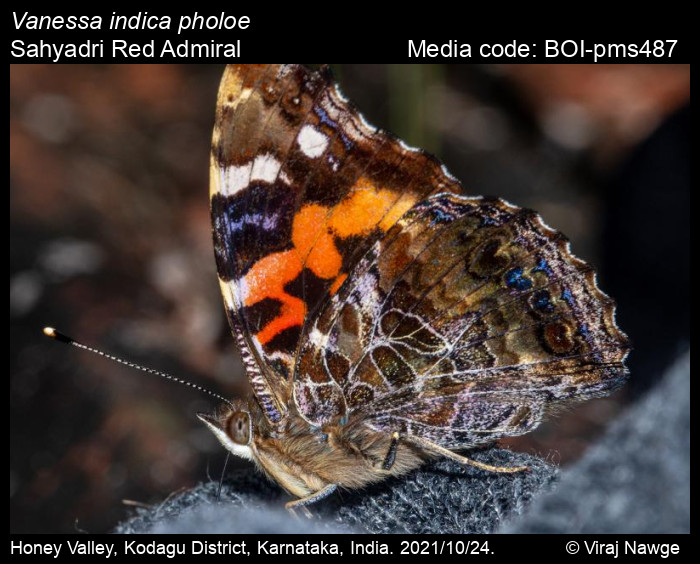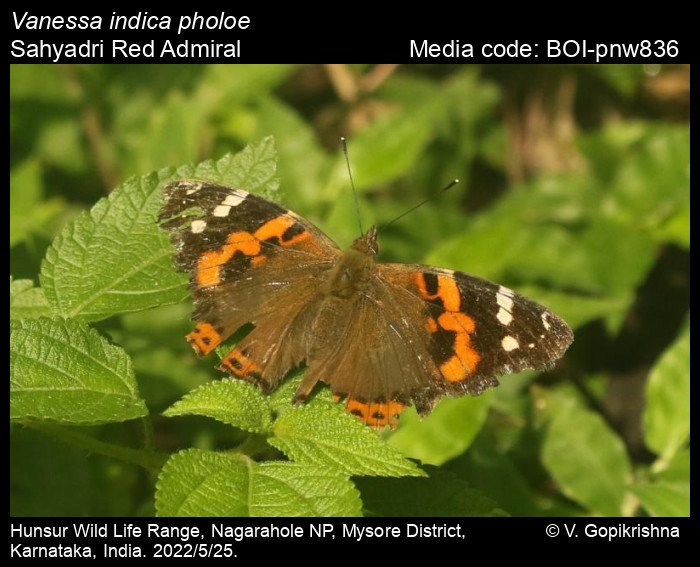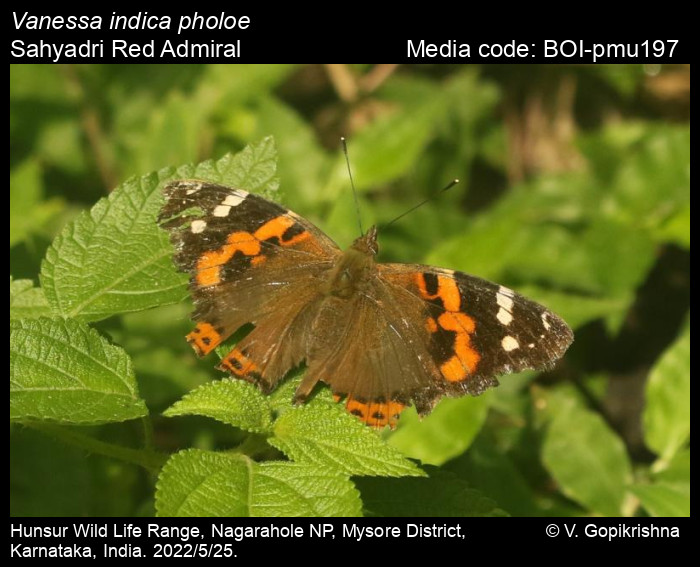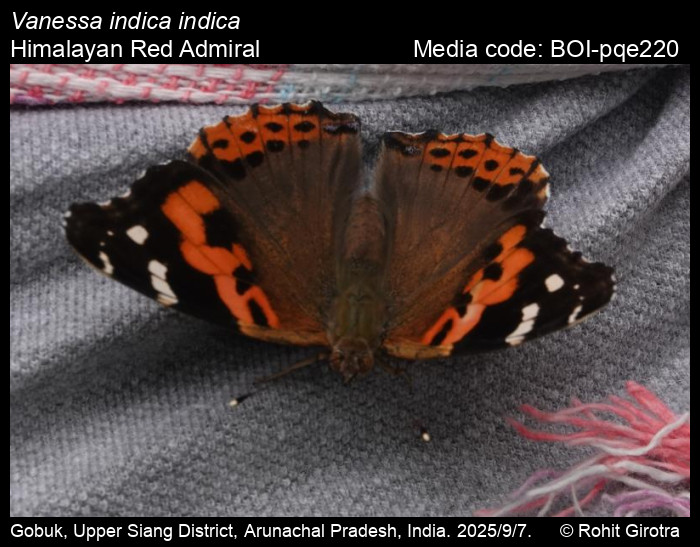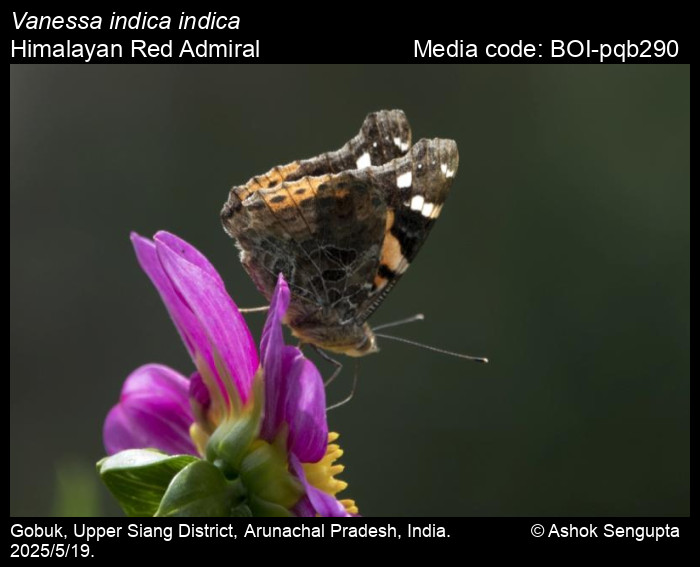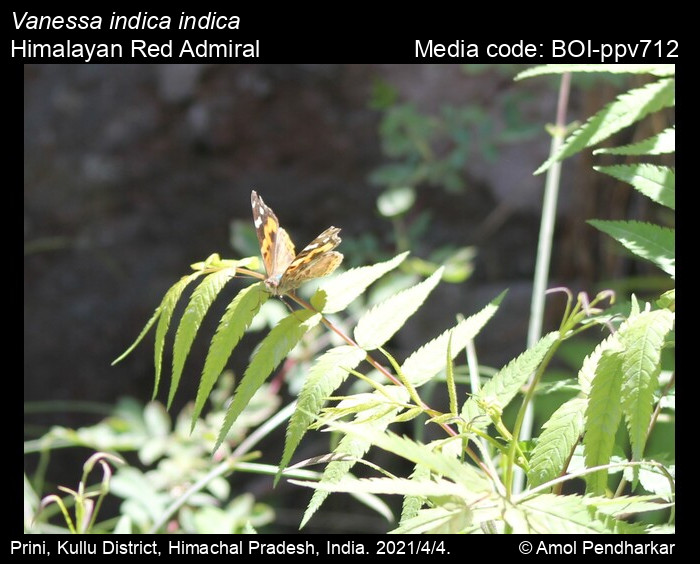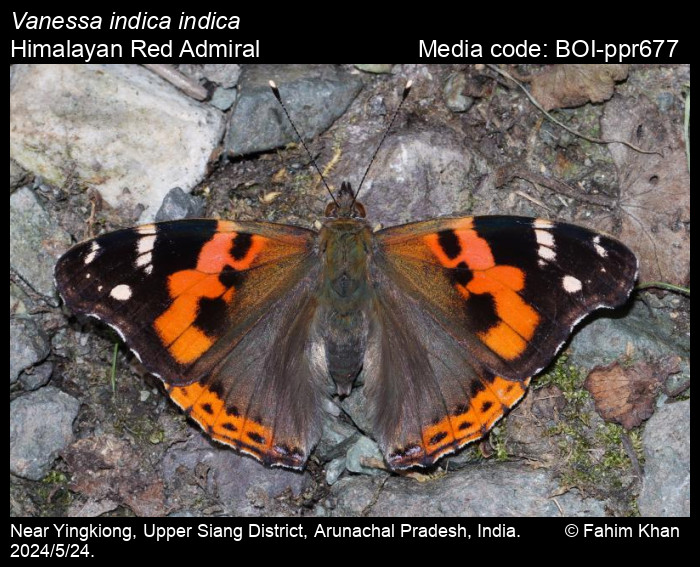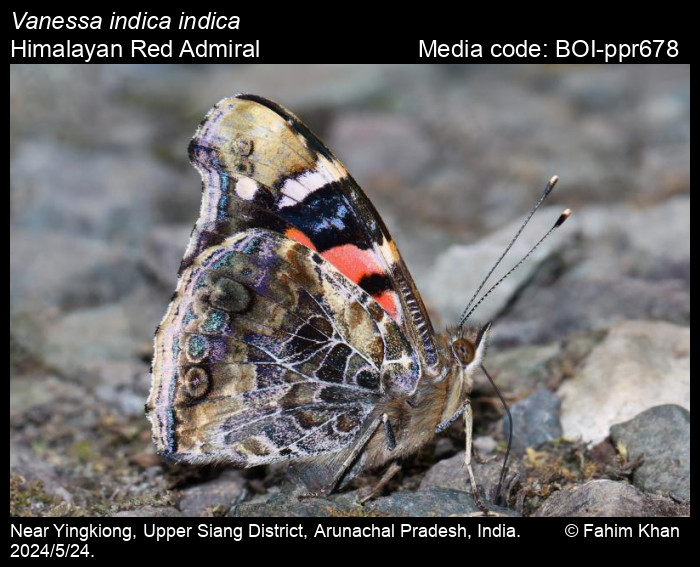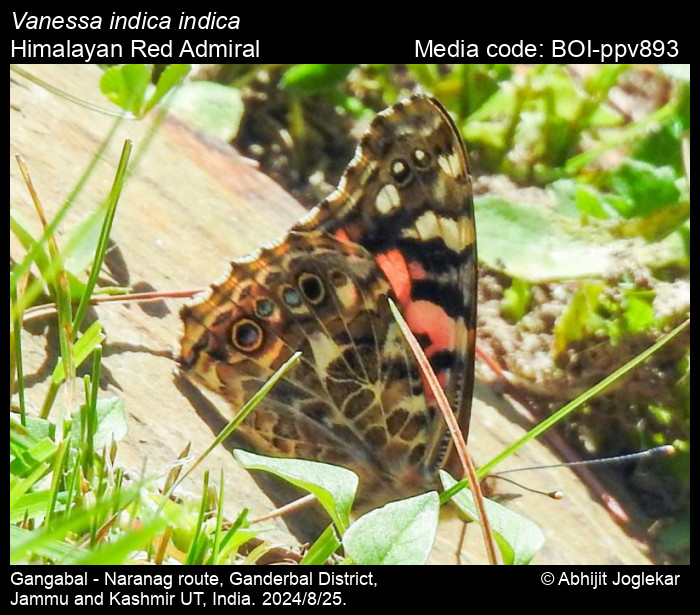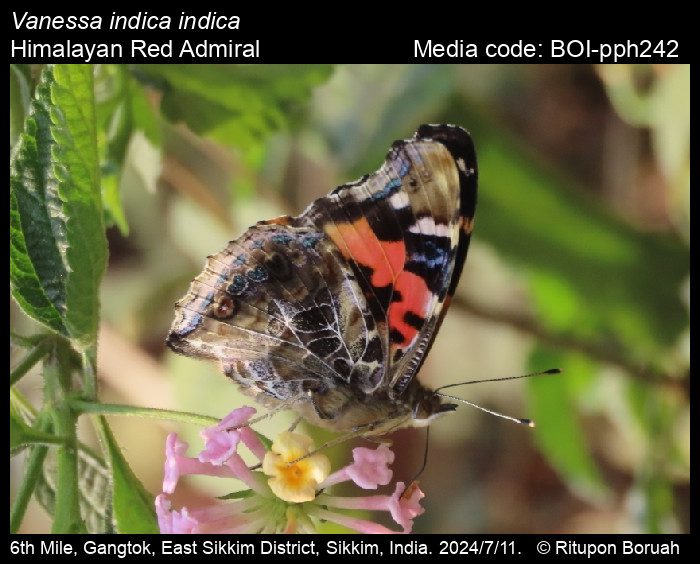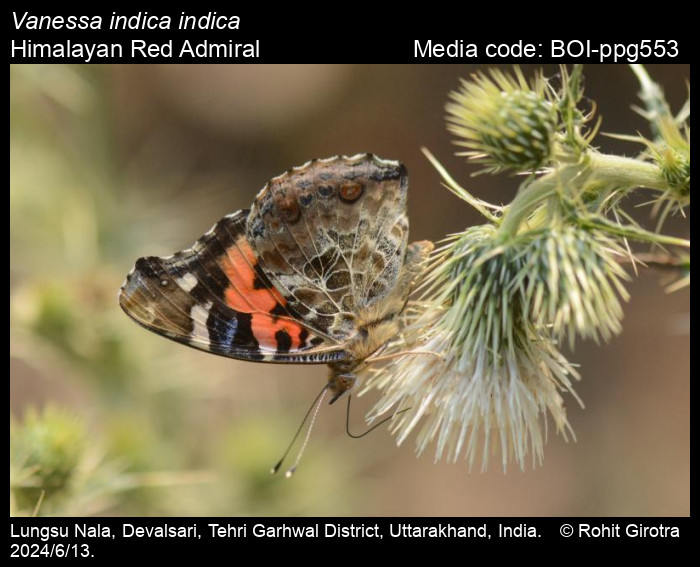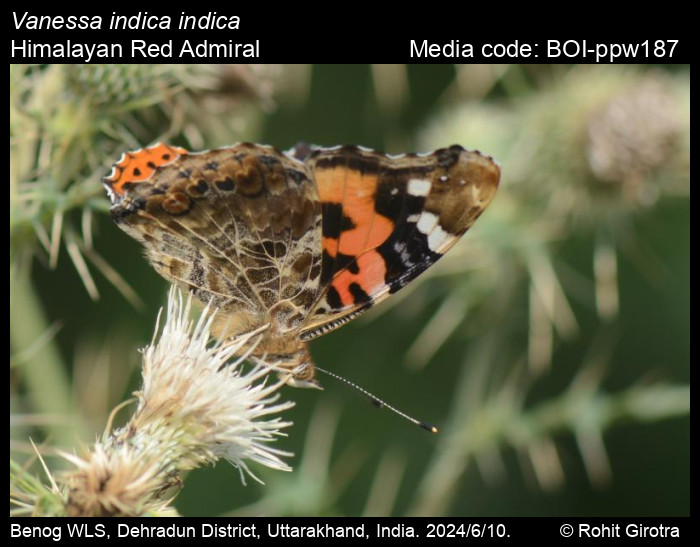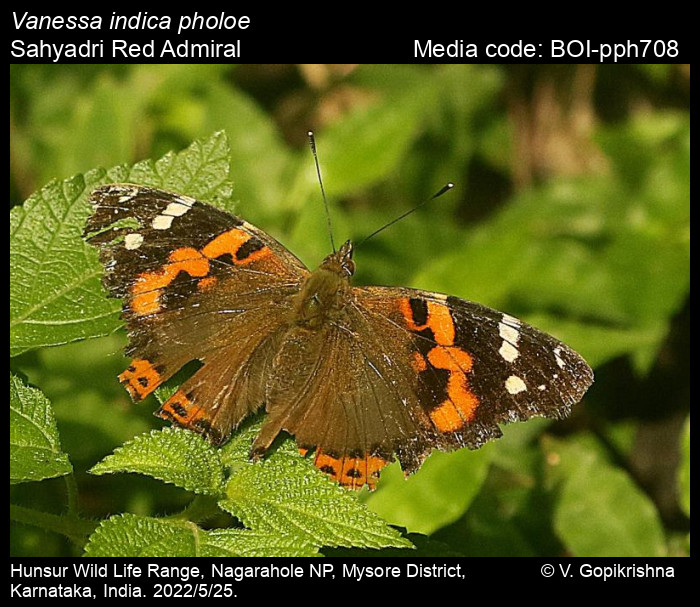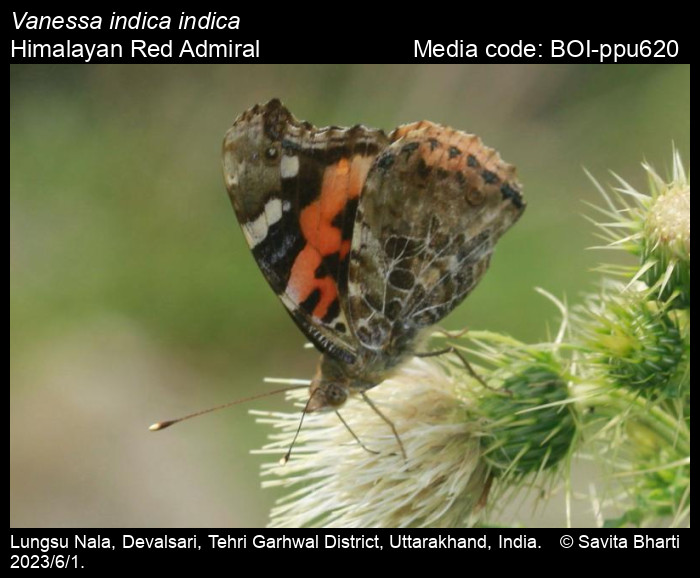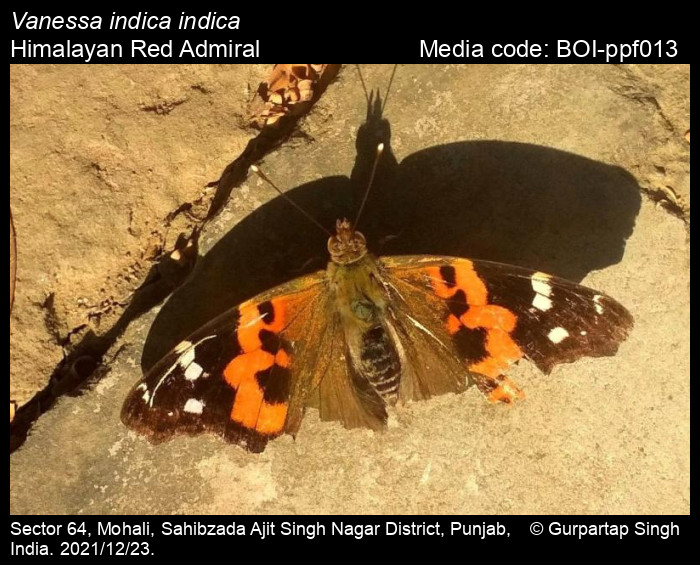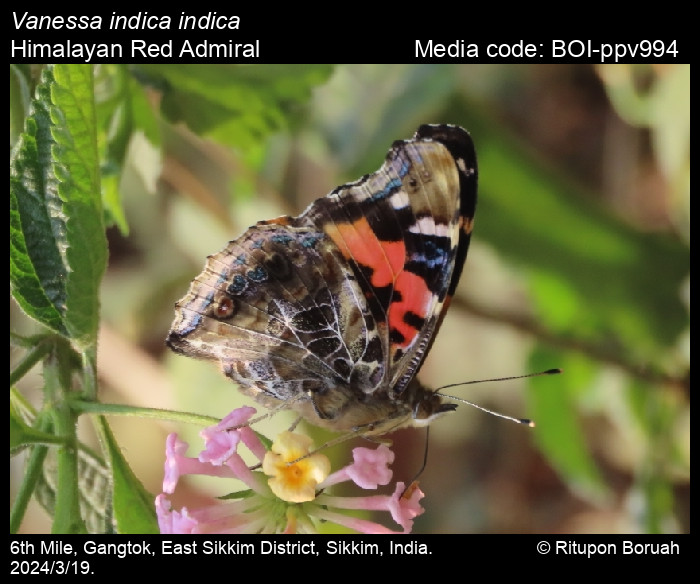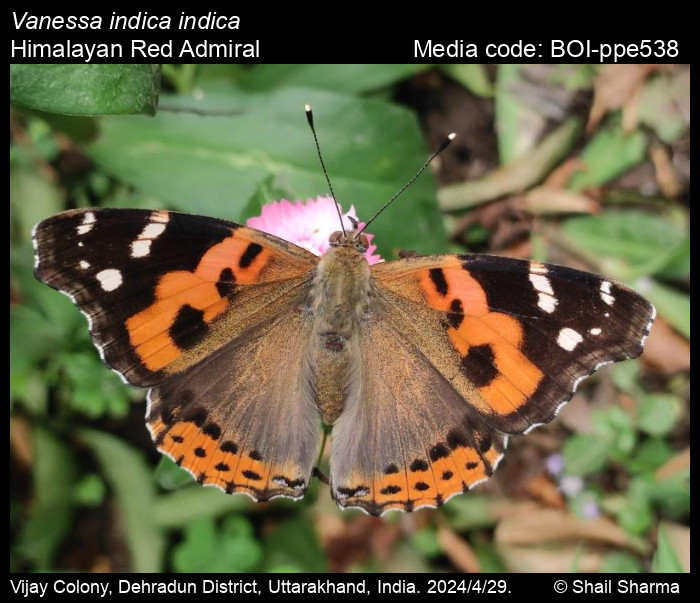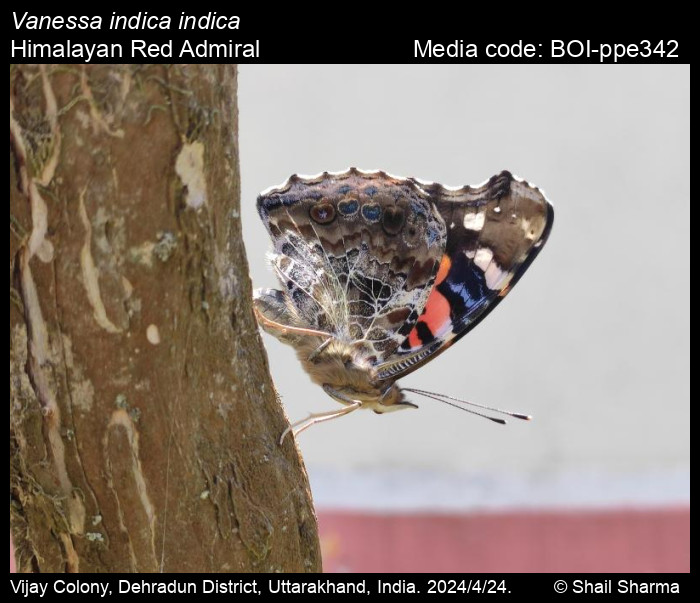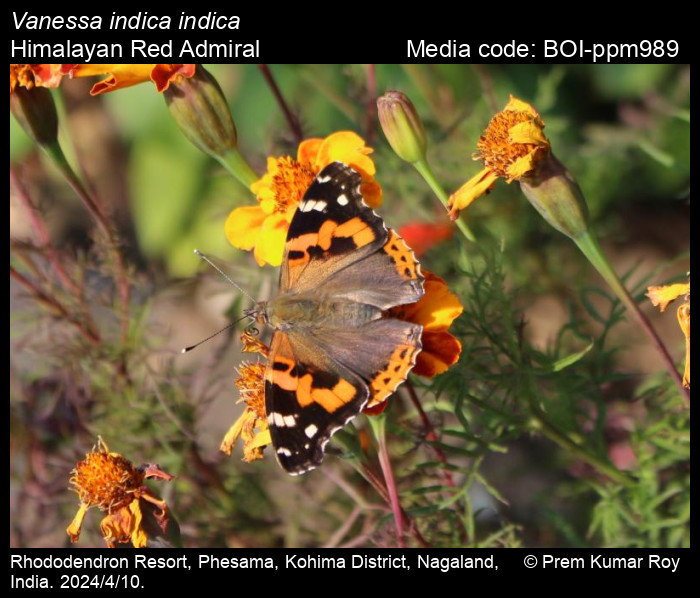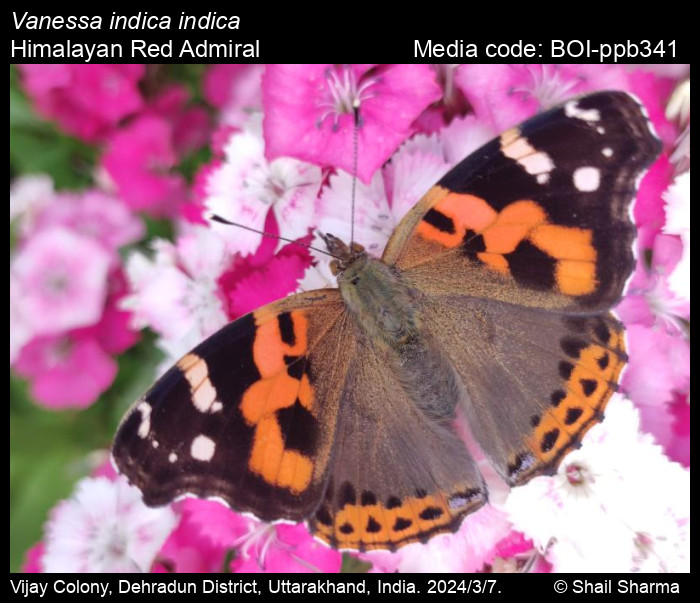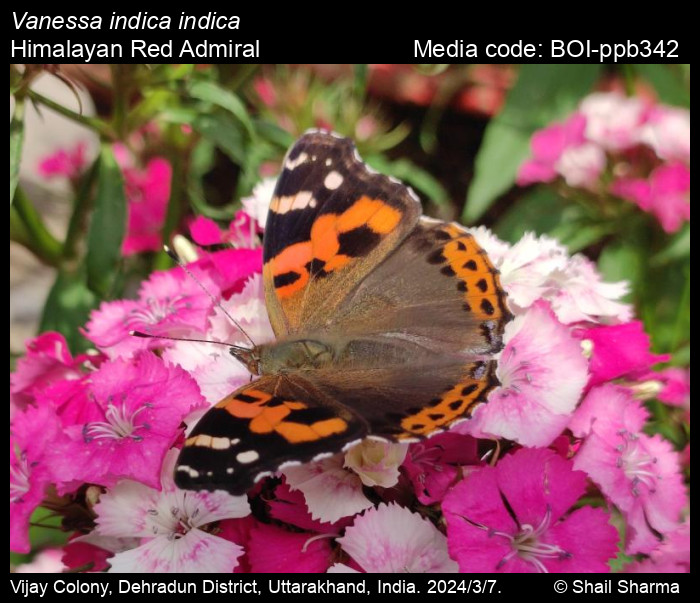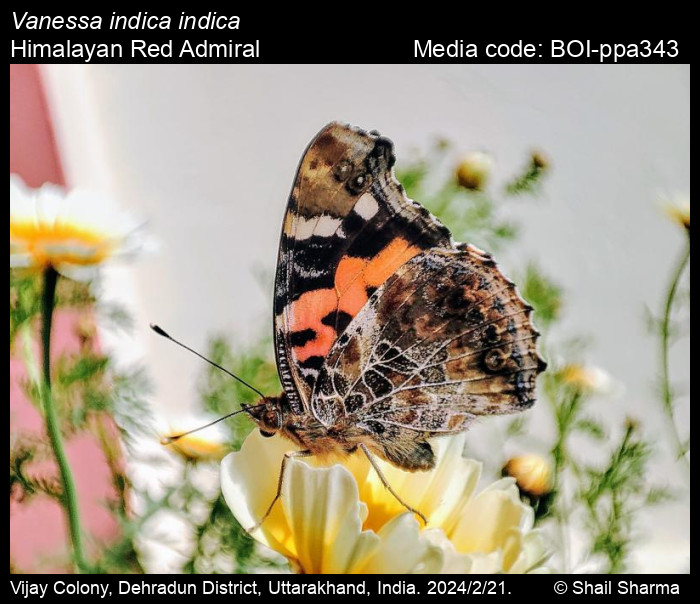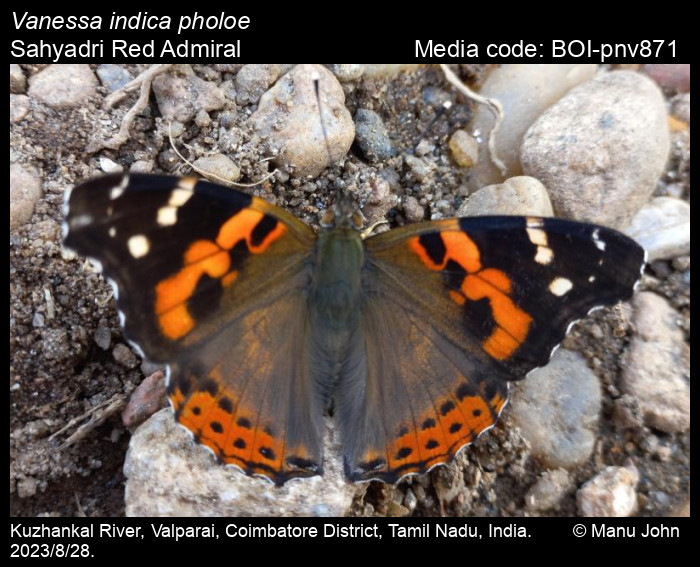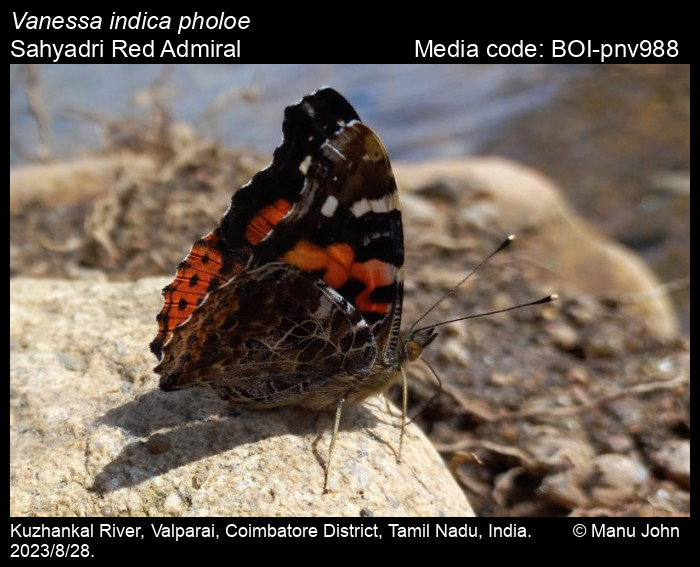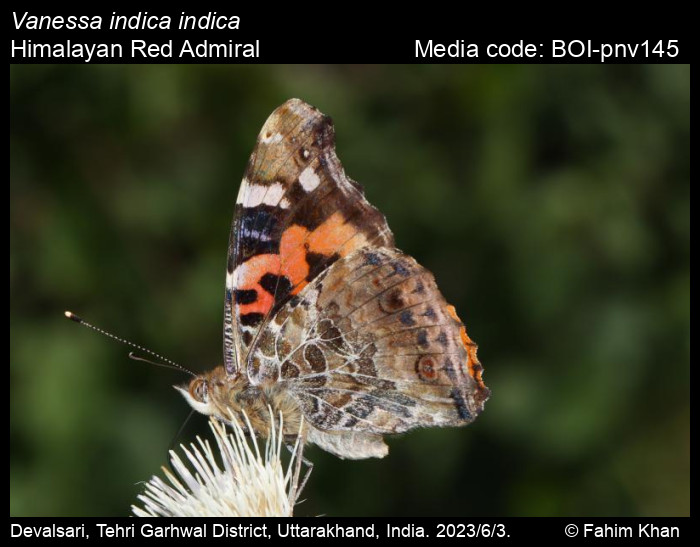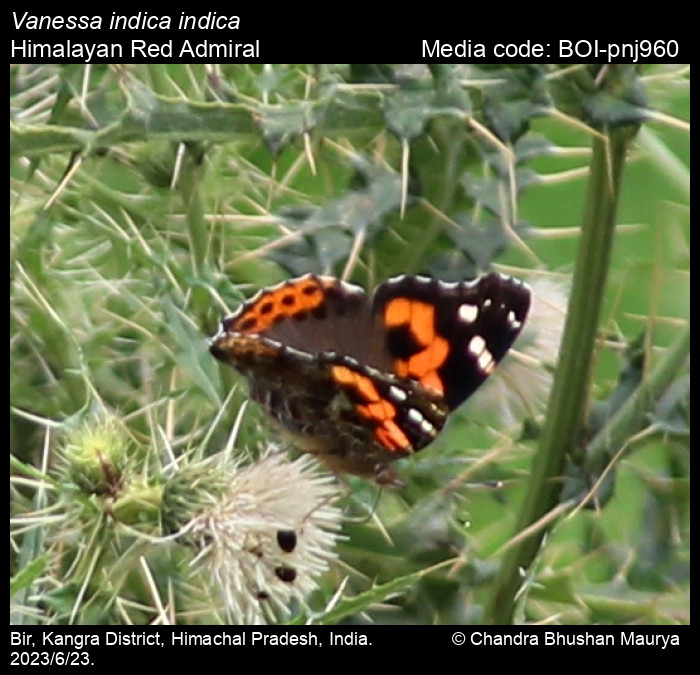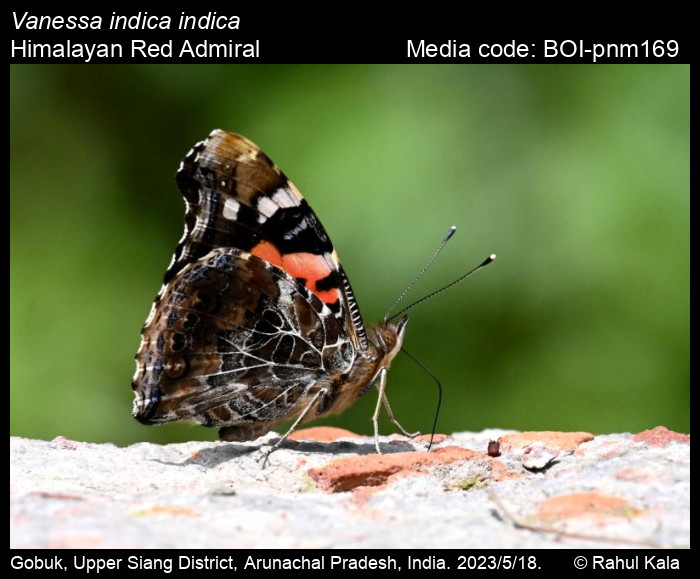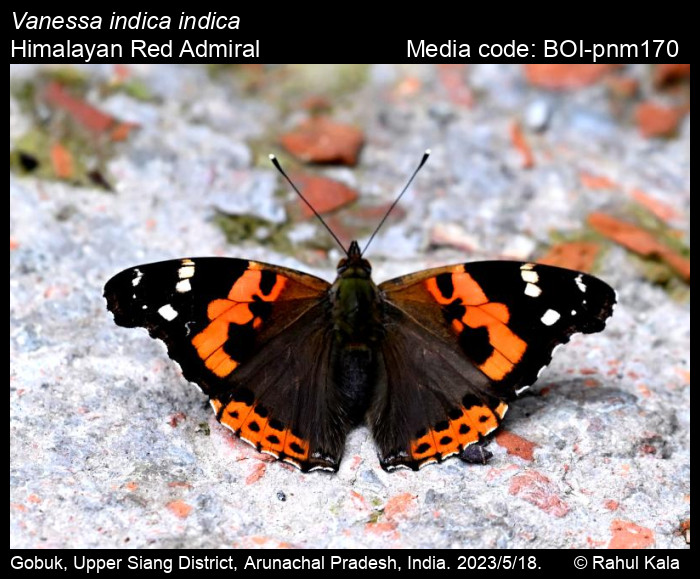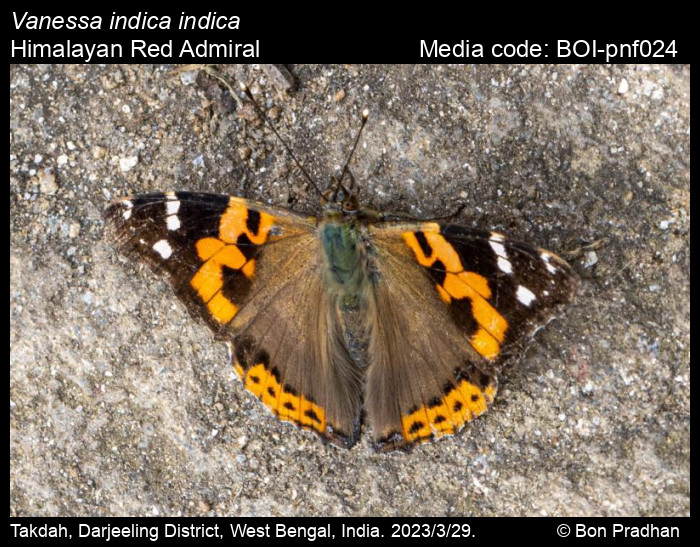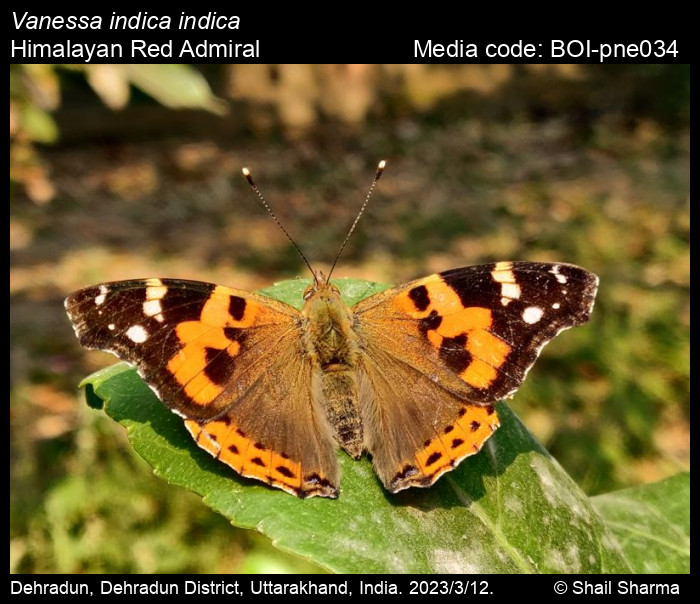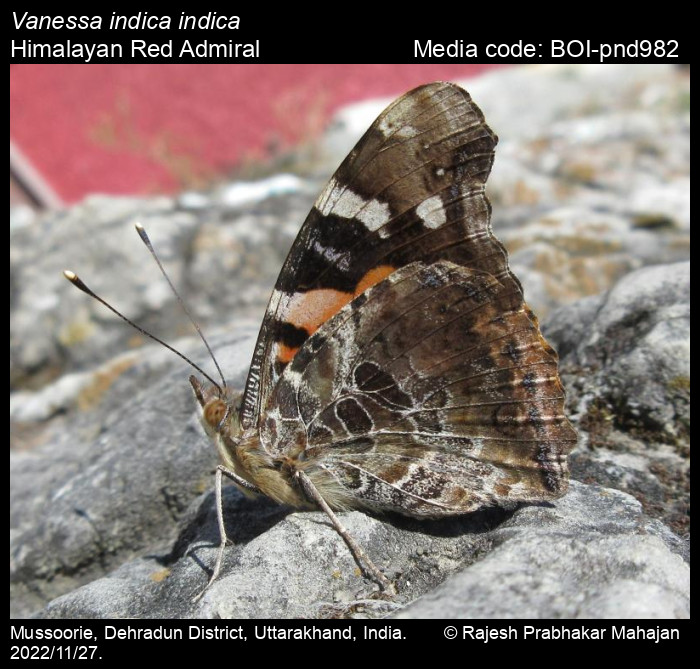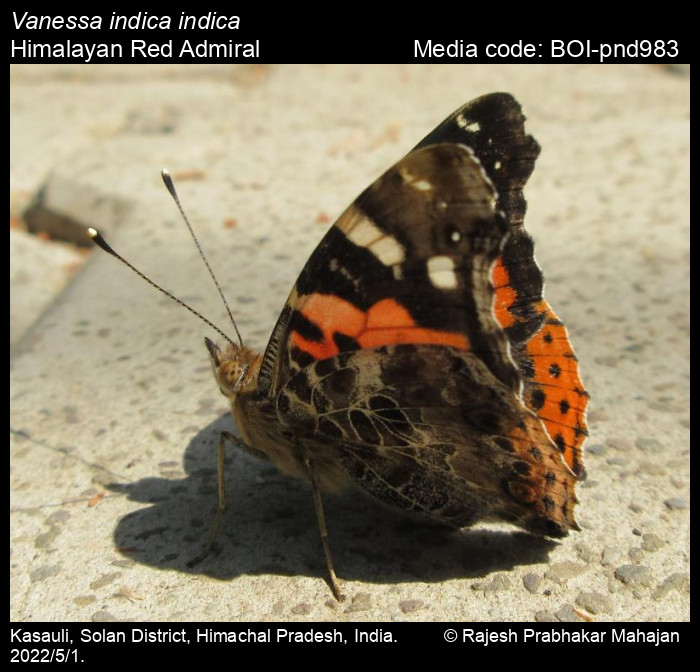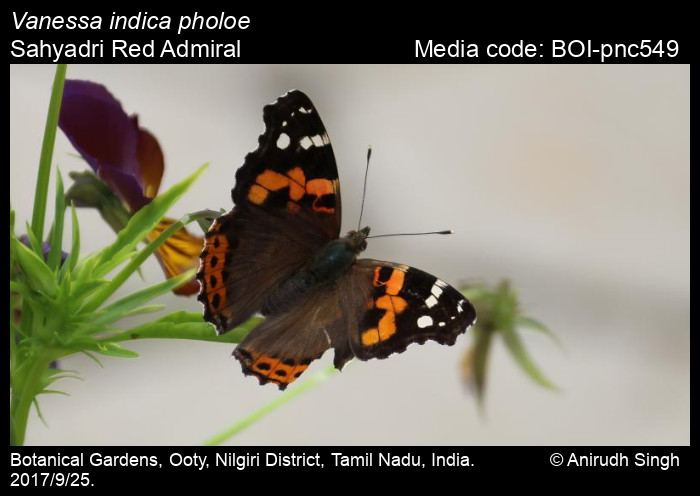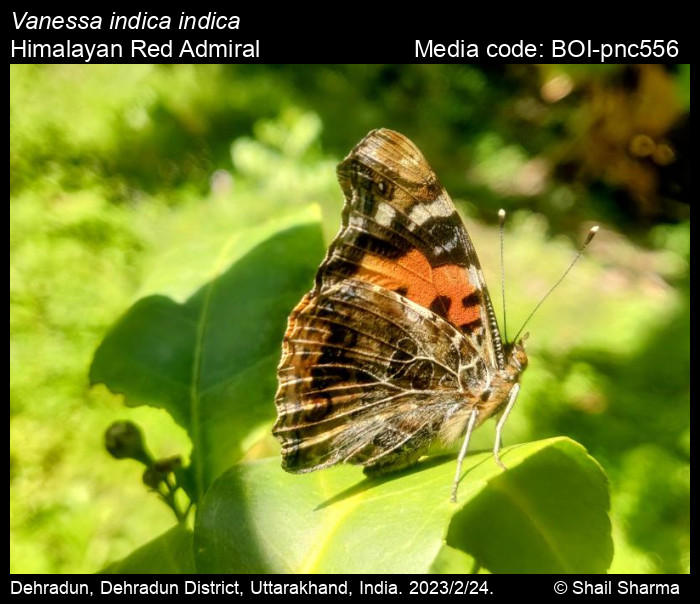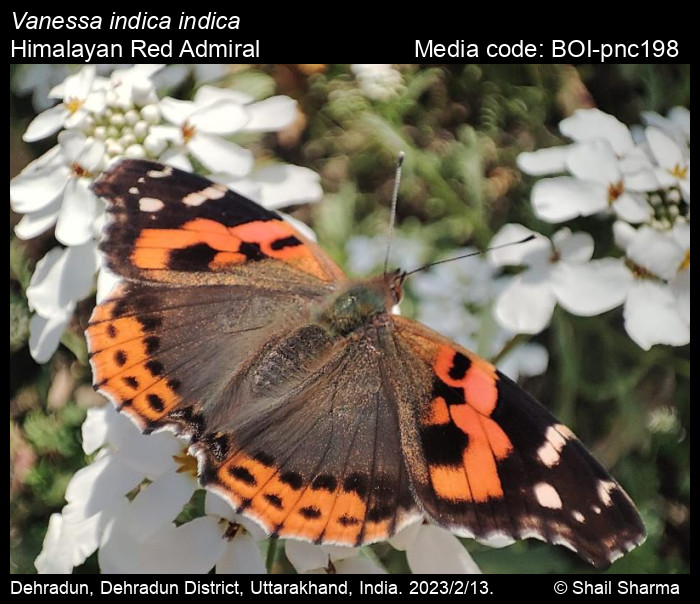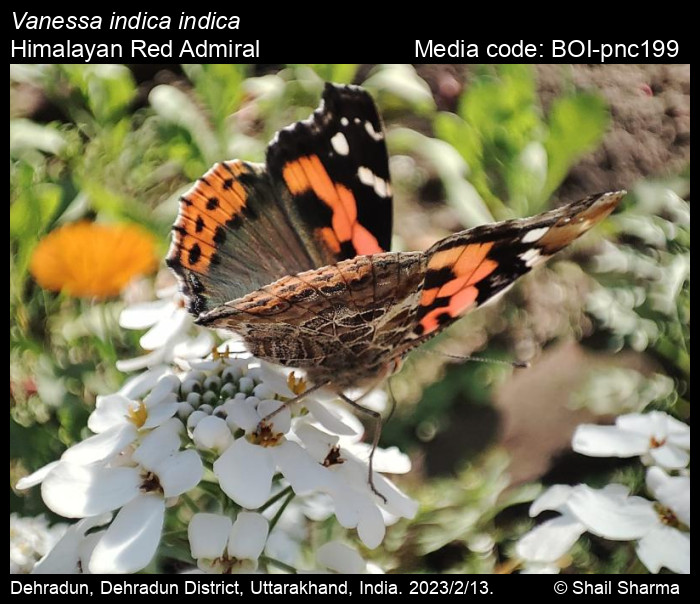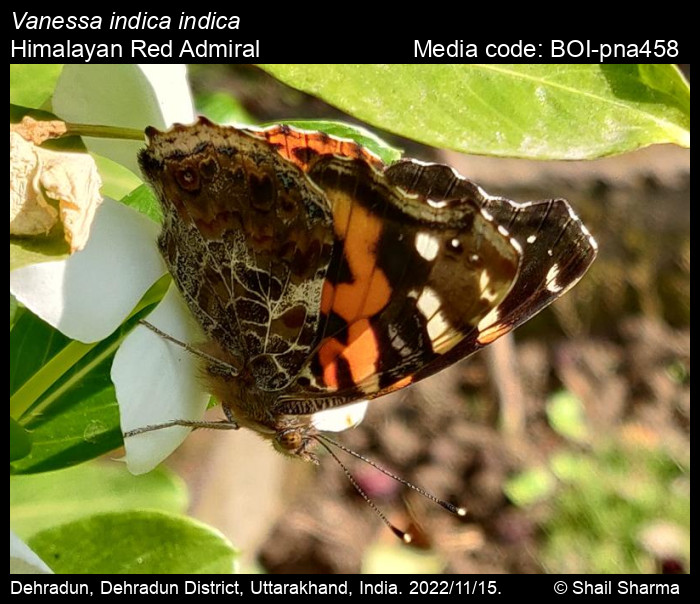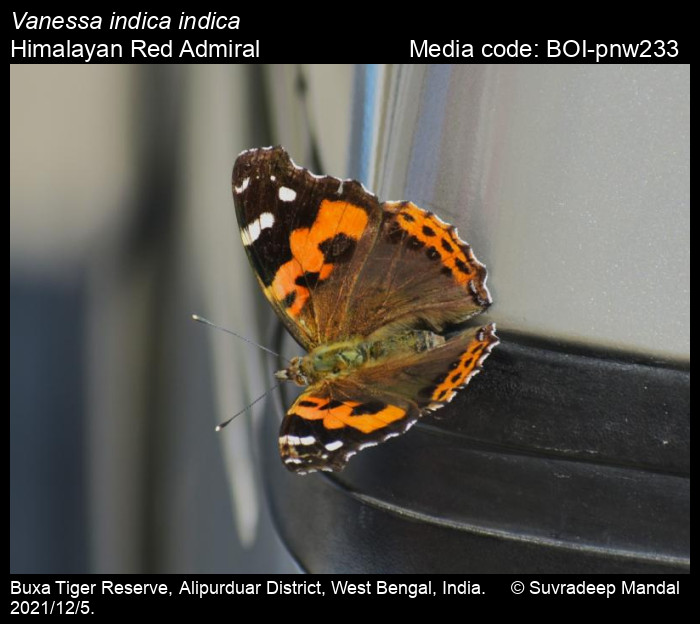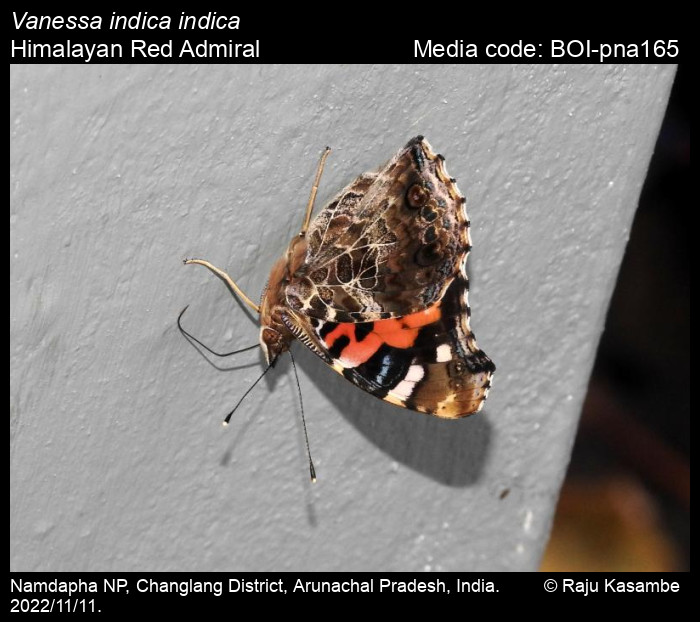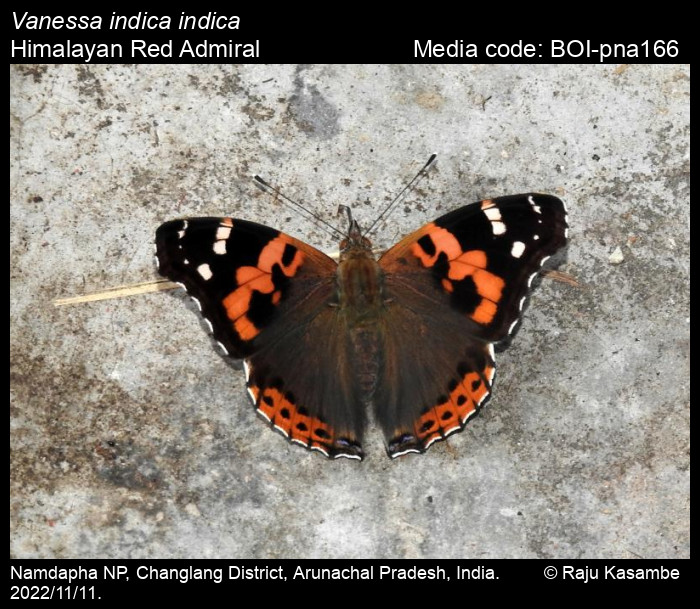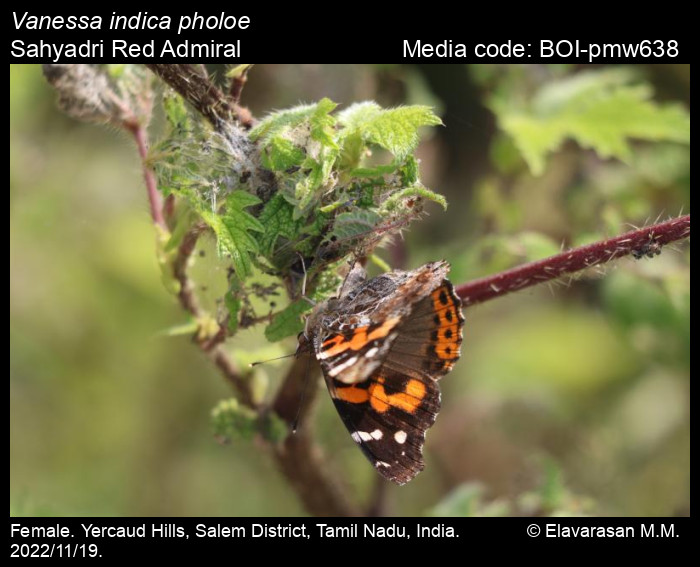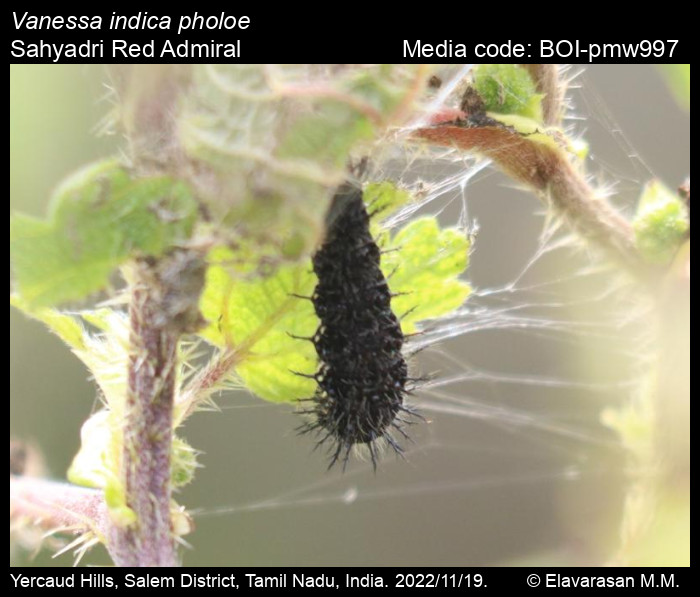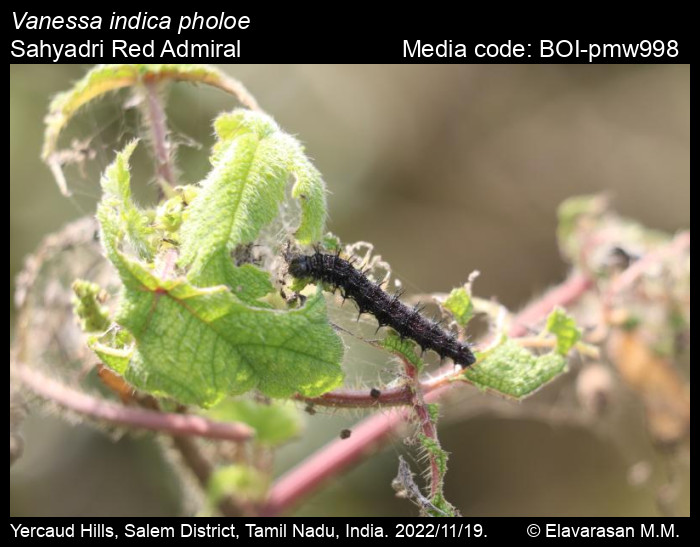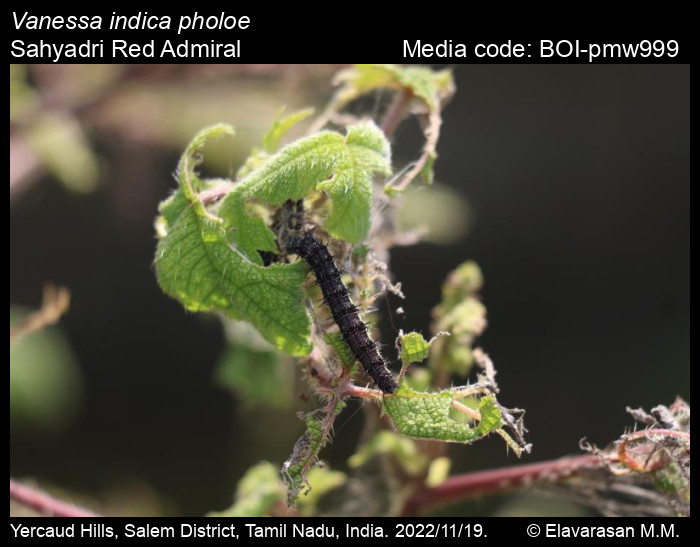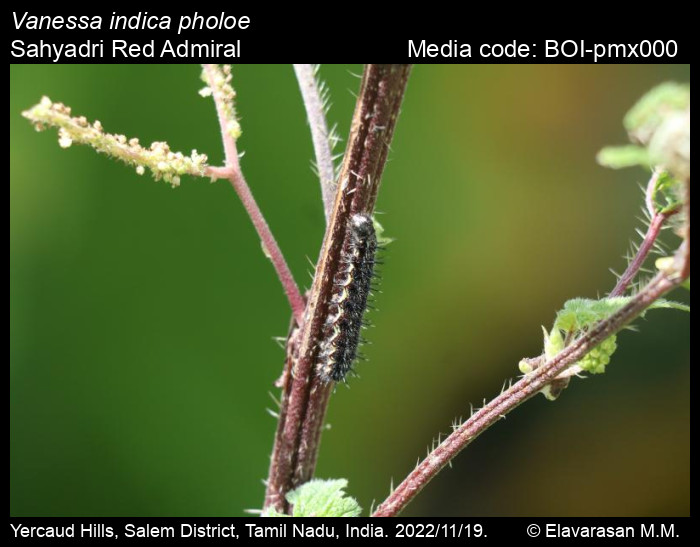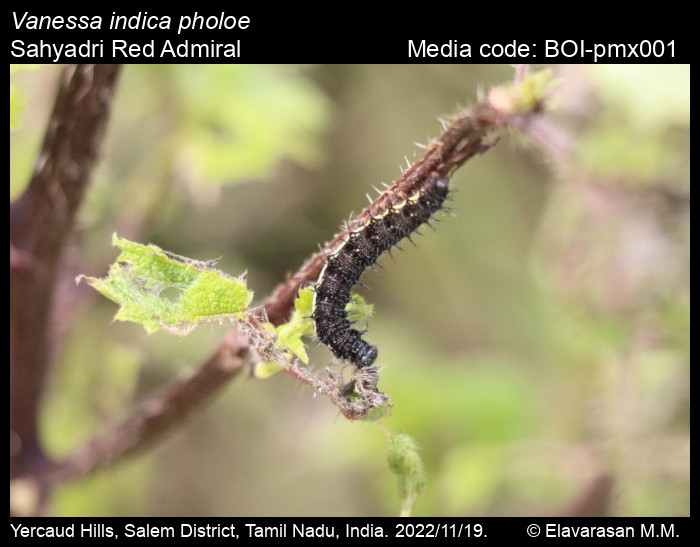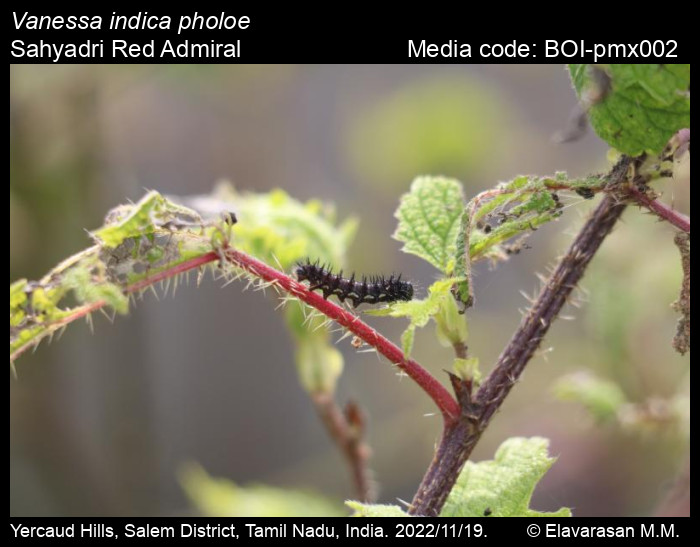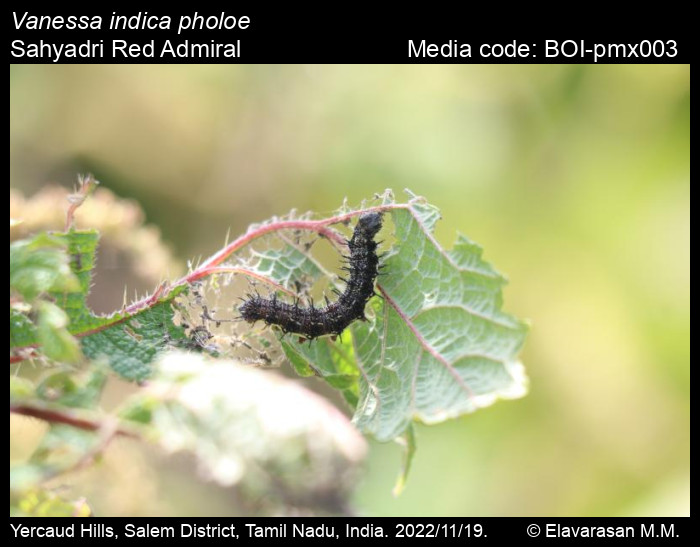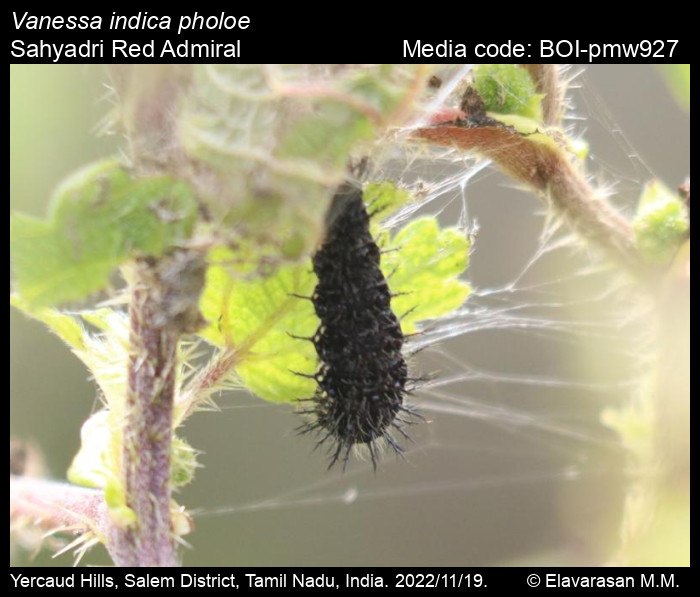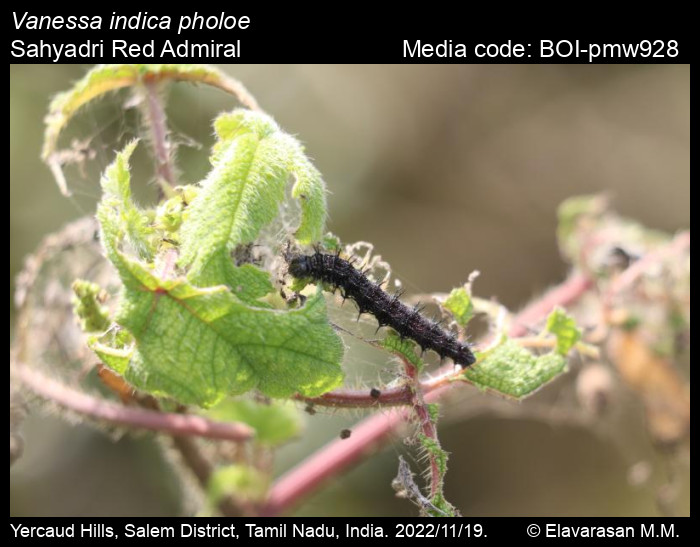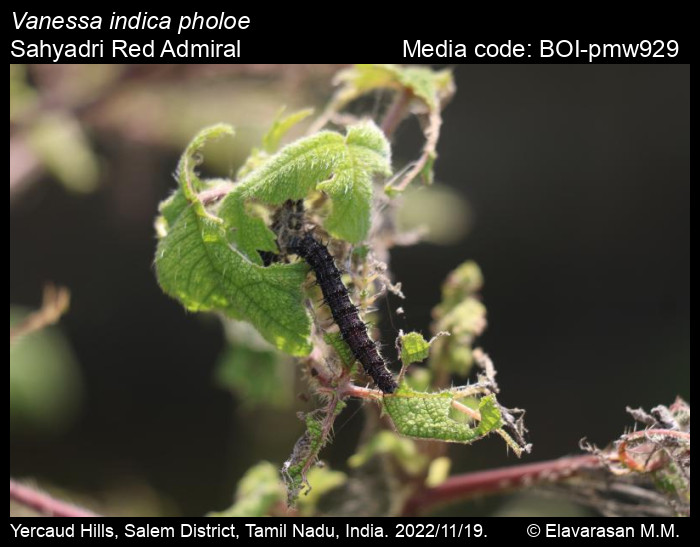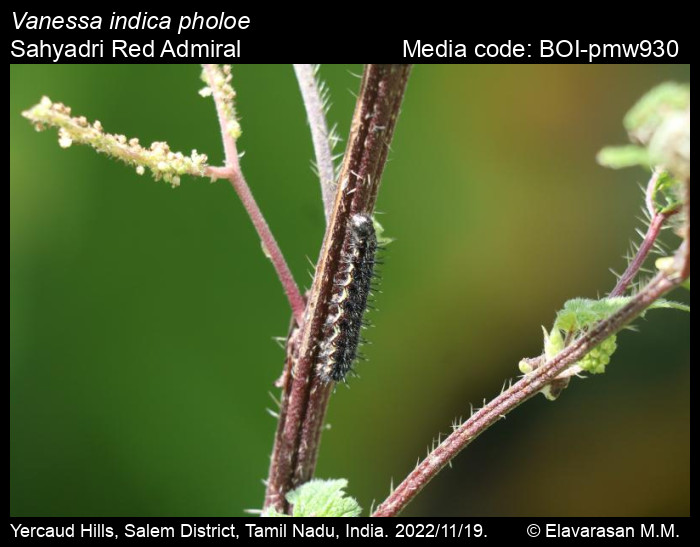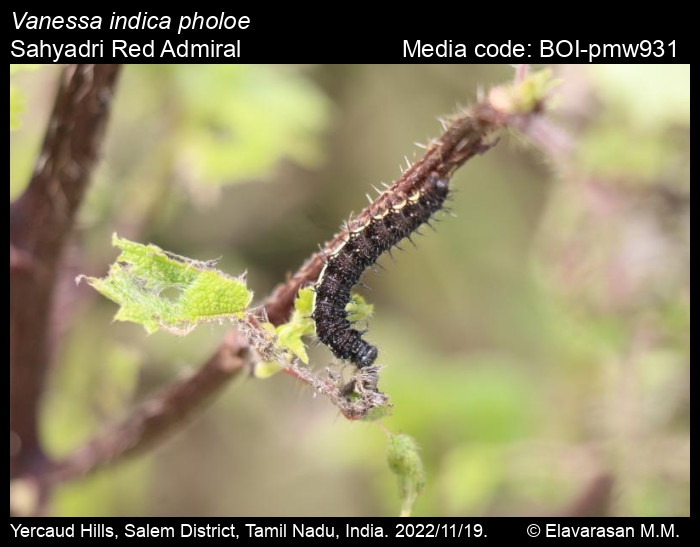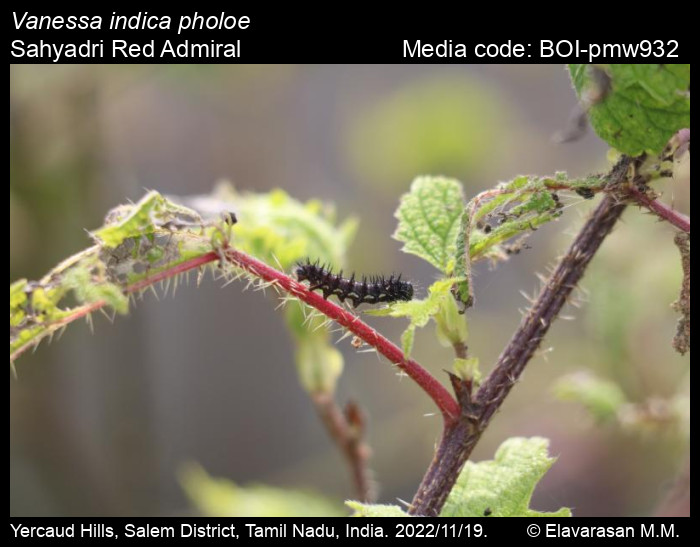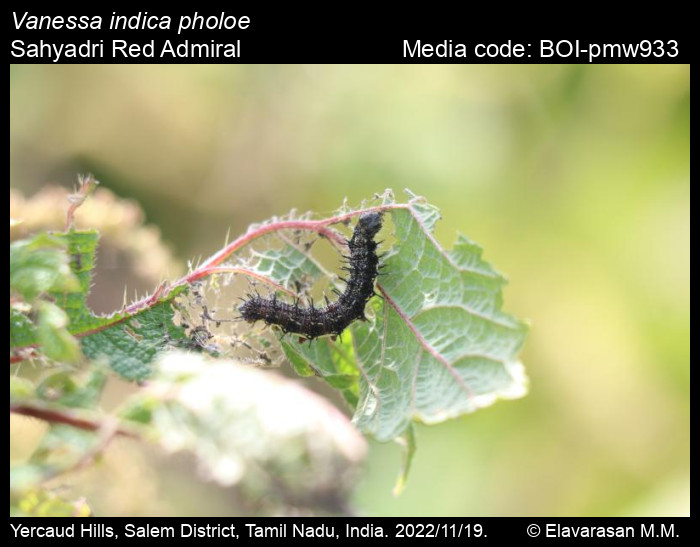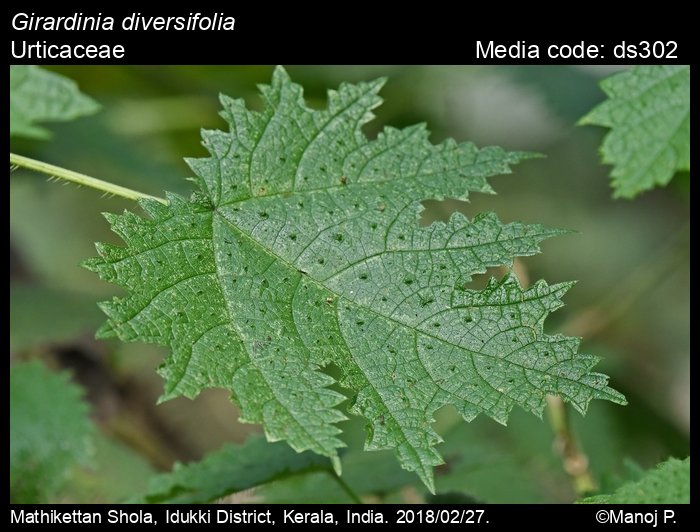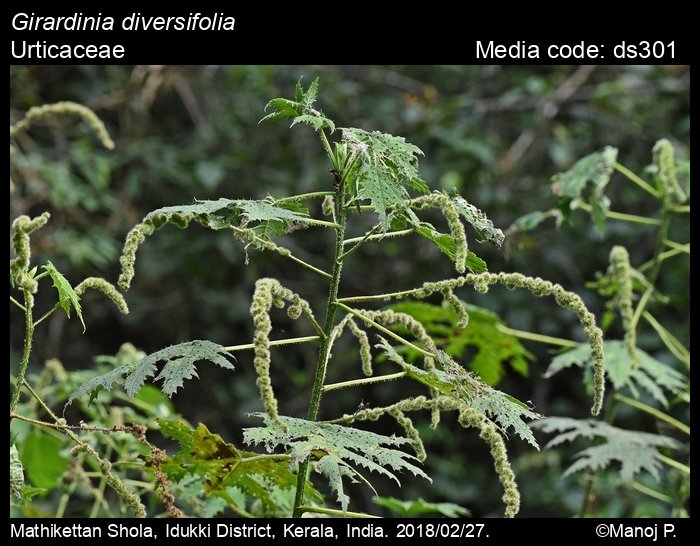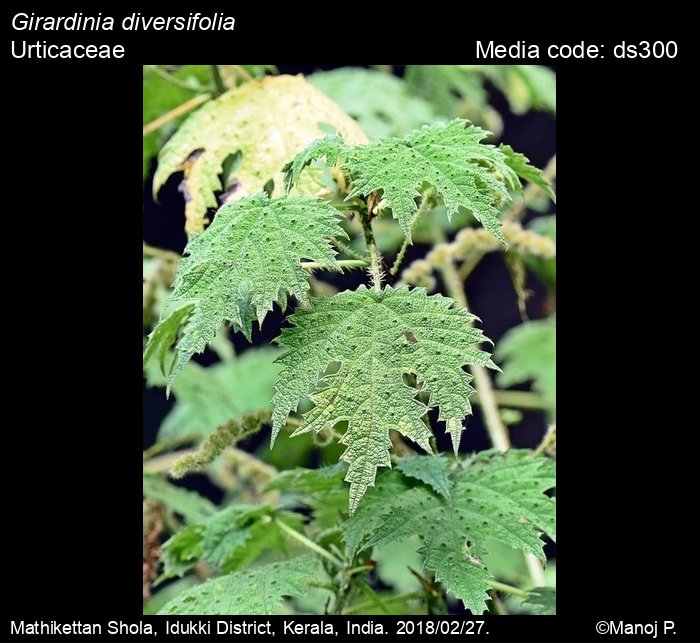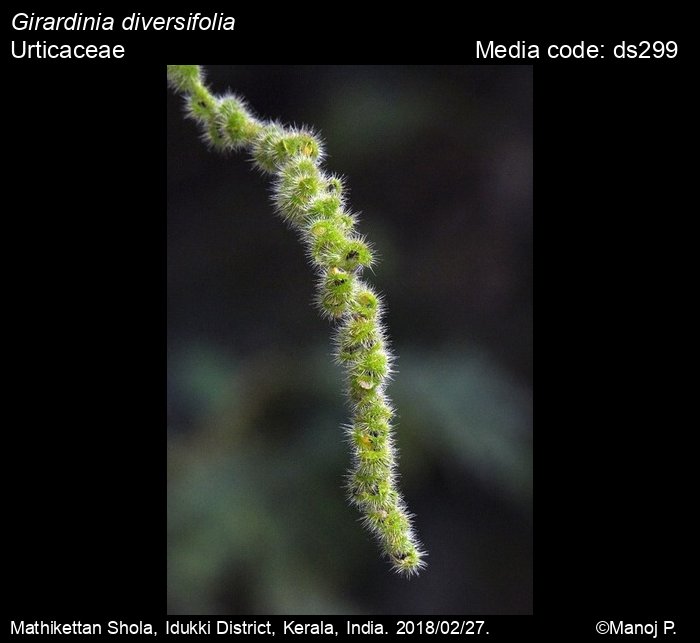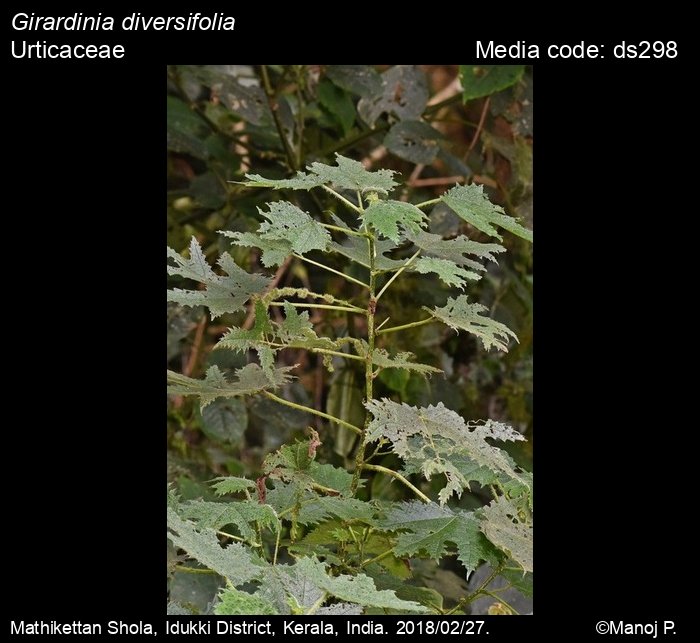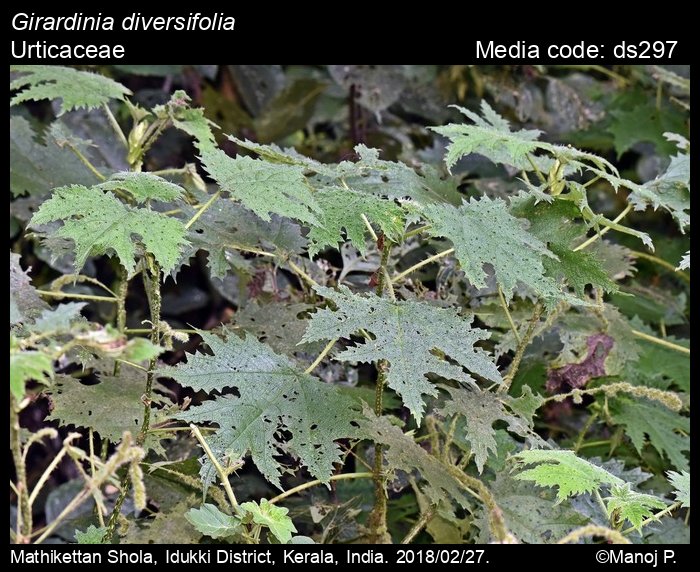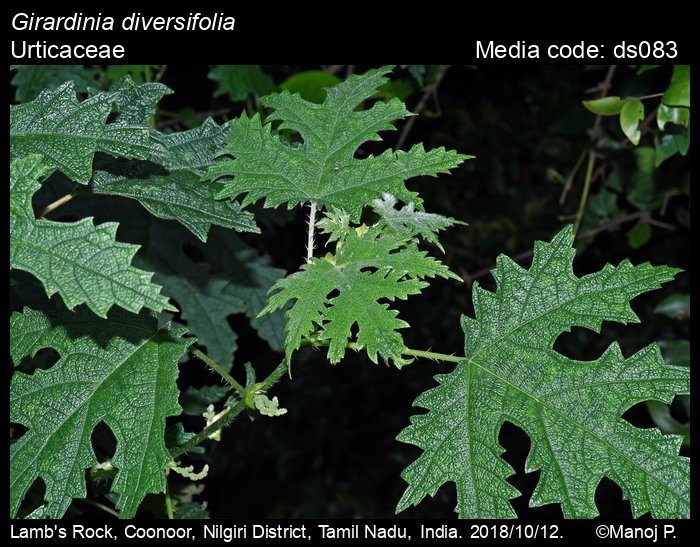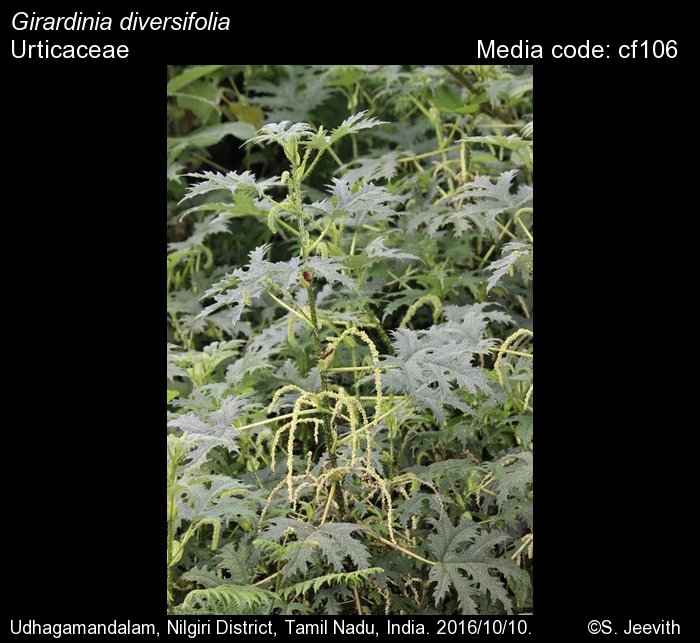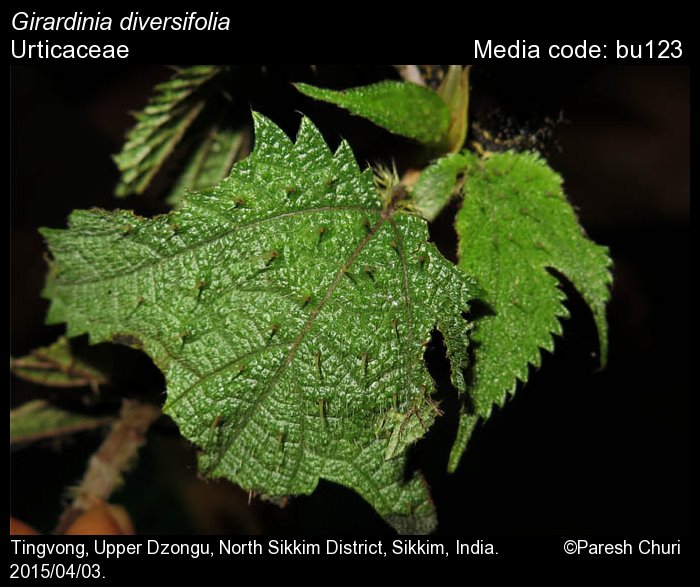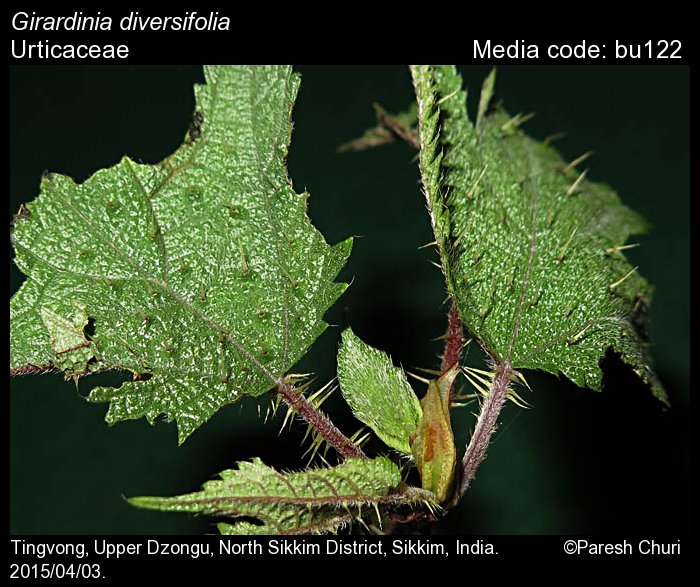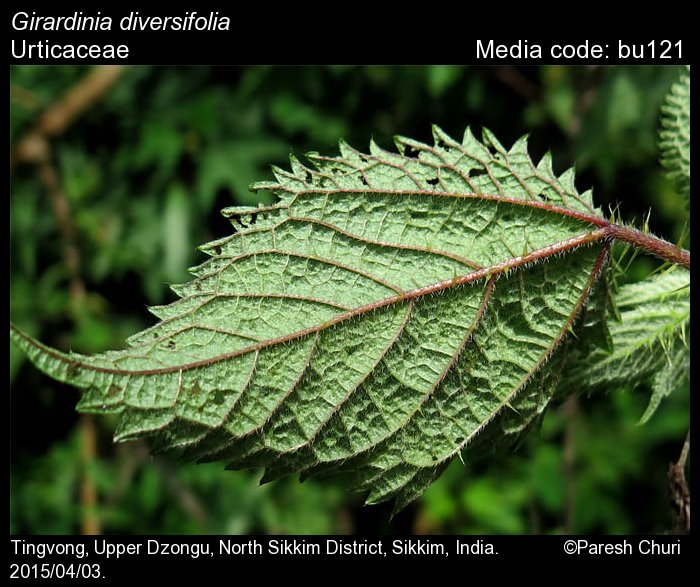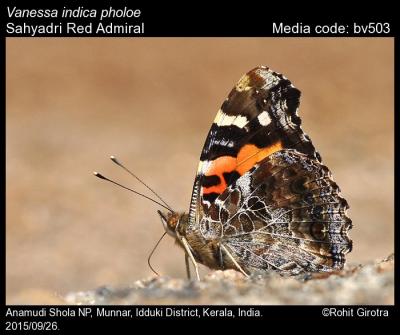
Subspecies in India
(2) Vanessa indica pholoe (Fruhstorfer, 1912) – Sahyadri Red Admiral
Photo Gallery and Species Biology
Eggs are only ca 0.7-0.9 mm in size, unusually small for that body size in butterflies, but similar in size to its relatives (Vanessa, Kaniska, Nymphalis, etc.). They are bright green with vertical, lighter green ridges. They are usually laid singly on the upperside of stinging nettle leaves, on stinging spines, but may be found anywhere on the plant. Sometimes they are laid in small batches of 2-4 eggs.
Newly hatched caterpillars are more hairy than spiny, brown, with black heads and no markings. The spines grow larger in successive instars. From second instar onward, caterpillars have a series of large white markings on the sides, which grow more prominent in successive instars. The fourth and fifth instars have white and yellow dots all over the body. The final instar is deep maroon-brown with creamy greenish yellow spines, and with a white-yellow dorsal band. The head remains black, but in later instars develops prominent white tubercles, each bearing a long shiny hair. There are no cephalic spines.
Caterpillars create loosely closed shelters for themselves. During the first and second instars, when they are too small to bend over leaf margins, they weave a thick mat of silk over their resting place. In later instars, they start to make loose cells by turning over leaf margins, or by drawing together margins of adjacent leaves. They lie inside the shelters curled sideways, and come out to feed when hungry. They change their shelters when a large part of the leaf is eaten and the shelters no longer adequately conceal them. They are easy to locate since they make prominent shelters, and they are reluctant to move even when their cells are opened or they are otherwise coaxed.
Pupae are also made inside shelters similar but larger to the larval shelters. They usually hang from near the margin rather than from the roof of the shelter. Pupae are either shiny marble-white or pale brown with two rows of small, light orange tubercles on the dorsal side of the abdomen. These tubercles are small near the tip of the abdomen and increase in size towards the thorax. The last three pairs of tubercles, just behind the pointed projection on the dorsal side of the thorax, have much larger, shiny silvery-golden bases. There is an additional pair of small tubercle on the thorax.
Sri Lanka, the Western Ghats, the Himalaya, NE India, Myanmar, China, Japan, Indo-China, SE Asia.
Subspecies V. i. indica occurs in the Himalaya, NE India, Myanmar, China, Japan, Indo-China and SE Asia. Subspecies V. i. pholoe is endemic to the Western Ghats.
Wingspan: 55-65mm. Upperside: Forewing brown at the base, black at the apex, with subapical white spots and a discal red band. Hindwing dark brown, unmarked, except for the black-spotted red margin. Wings have a golden and bronze sheen, especially near the bases. Underside: dark brown with fine grey, greenish, brown and black markings, which aid in camouflage.
Subspecies pholoe differs from indica in having the lower two black spots on red discal band of the upperside forewing joined to each other. These spots are usually detached in subspecies indica. Similar species in India: Vanessa cardui (Painted Lady) differs in having red hindwing with numerous black spots, and overall much lighter red wings. The spotting pattern also differs in detail (compare pictures). The underside is much lighter but similarly camouflaging.
A common species from hilly regions of the country. It usually flies from approx. 500m to 3,500m asl but it is much commoner at mid-elevations (1,200m to 2,500m). It flies throughout the year in the Western Ghats, the Himalaya and NE India at mid- and lower elevations, although it is commoner before and after the rainy season. In these areas it produces multiple broods every year. It flies only from April-May to early October at higher elevations, where it finishes two broods and spends the rest of the year hibernating.
In the Western Ghats it is common in the montane shola-grassland mosaics from Karnataka to Kerala, occasionally descending to lower evergreen forests. In the Himalaya and NE India, it frequents open forests, flower-clad meadows, village outskirts and gardens. It is especially common along forest paths and other forest openings, where stinging nettles, its larval host plants, grow in clumps. It is a common sight at popular hill stations in the Nilgiri and Palni Hills in the Western Ghats, and in Uttaranchal, Himachal Pradesh, Sikkim, West Bengal and Arunachal Pradesh.
Males are more frequently seen than females. Both sexes are attracted to rotting fruits and animal dung, plant sap and flowers. Males often mud-puddle and are attracted to sweaty limbs of trekkers, which they vigorously defend from other butterflies. Males also hill-top and patrol ridges and forest paths, where they chase passing butterflies. They are very wary when not feeding, they keep their distance, so it is sometimes difficult to obtain good close-up pictures. Females tend to be much more tolerant of human observers near their host plants. When disturbed, both sexes sometimes perch on tree-trunks with the wings closed and head pointing to the ground. Owing to their cryptic undersides, they are extremely difficult to spot in this position.
They bask low on rocks, paths and vegetation, with their wings spread flat. They are very strong on the wings, they fly with rapid wing beats, which, at times, can be audible.
| State | Jan | Feb | Mar | Apr | May | Jun | Jul | Aug | Sep | Oct | Nov | Dec | No date |
|---|---|---|---|---|---|---|---|---|---|---|---|---|---|
| Andaman and Nicobar Islands UT | |||||||||||||
| Andhra Pradesh | |||||||||||||
| Arunachal Pradesh | 5 | 1 | 1 | 1 | |||||||||
| Assam | |||||||||||||
| Bihar | |||||||||||||
| Chandigarh | |||||||||||||
| Chhattisgarh | |||||||||||||
| Dadra & Nagar Haveli UT | |||||||||||||
| Daman & Diu UT | |||||||||||||
| Delhi | |||||||||||||
| Goa | |||||||||||||
| Gujarat | |||||||||||||
| Haryana | |||||||||||||
| Himachal Pradesh | 1 | 3 | 1 | ||||||||||
| Jammu and Kashmir UT | 1 | 1 | 1 | ||||||||||
| Jharkhand | |||||||||||||
| Karnataka | 1 | 2 | 1 | 1 | |||||||||
| Kerala | |||||||||||||
| Ladakh UT | |||||||||||||
| Lakshadweep | |||||||||||||
| Madhya Pradesh | |||||||||||||
| Maharashtra | |||||||||||||
| Manipur | |||||||||||||
| Meghalaya | |||||||||||||
| Mizoram | |||||||||||||
| Nagaland | 1 | ||||||||||||
| Odisha | |||||||||||||
| Puducherry UT | |||||||||||||
| Punjab | 1 | ||||||||||||
| Rajasthan | |||||||||||||
| Sikkim | 1 | 2 | 5 | ||||||||||
| Tamil Nadu | 2 | 1 | 3 | ||||||||||
| Telangana | |||||||||||||
| Tripura | |||||||||||||
| Uttar Pradesh | |||||||||||||
| Uttarakhand | 3 | 2 | 2 | 4 | 2 | ||||||||
| West Bengal | 1 | 4 | 1 | ||||||||||
| Total | 1 | 3 | 4 | 9 | 10 | 6 | 2 | 8 | 2 | 1 | 8 | 2 |
Predominantly bushy stinging nettles of genera Girardinia, Urtica and Boehmeria (Urticaceae), which often grow in large clumps near villages and in openings in mid-elevation forests. Care is needed when picking off caterpillars and pupae from the plants or when feeding caterpillars in captivity, as the plants have stinging spines on leaves and stems. Depending on the species and individual plants, the stings can be quite painful, and they itch for hours, if not days. Other plants have also been reported as larval hosts of this butterfly, although they are not commonly used: Blumea (Asteraceae), Zornia (Fabaceae), Corchorus (Tiliaceae) and Ulmus (Ulmaceae).
Bascombe, M. J., G. Johnston and F. S. Bascombe. 1999. The Butterflies of Hong Kong. Academic Press, London.
Evans, W. H. 1932. The Identification of Indian butterflies. 2nd ed. Bombay Natural History Society, Mumbai.
Roberts, T. J. 2001. The Butterflies of Pakistan. Oxford University Press, Oxford.
Robinson, G. S., P. R. Ackery, I. J. Kitching, G. W. Beccaloni and L. M. Hernández. 2001. Hostplants of the Moth and Butterfly Caterpillars of the Oriental Region. Natural History Museum, London.
Smith, C. 1989. Butterflies of Nepal (Central Himalaya). Tecpress Service L.P., Bangkok.
Wynter-Blyth, M. A. 1957. Butterflies of the Indian Region. Bombay Natural History Society, Mumbai.
Page citation
Kunte, K. & A. Sengupta 2025. Vanessa indica (Herbst, 1794) – Indian Red Admiral. In Kunte, K., S. Sondhi, and P. Roy (Chief Editors). Butterflies of India, v. 4.12. Published by the Indian Foundation for Butterflies. URL: https://www.ifoundbutterflies.org/vanessa-indica, accessed 2025/12/06.
